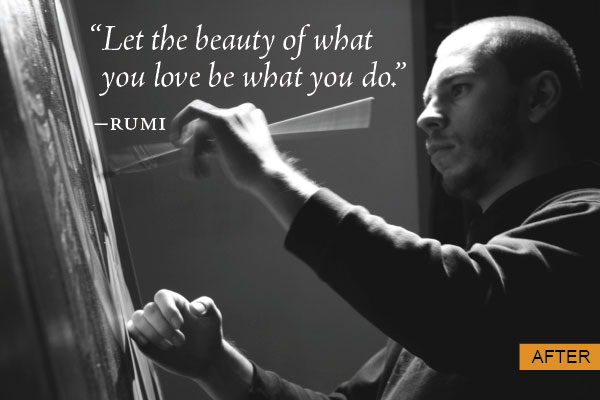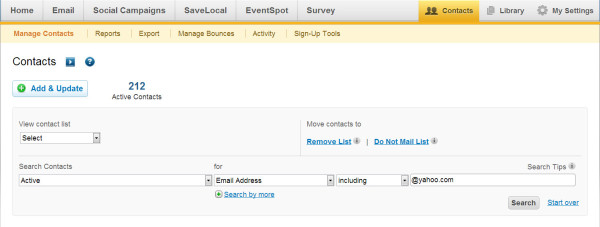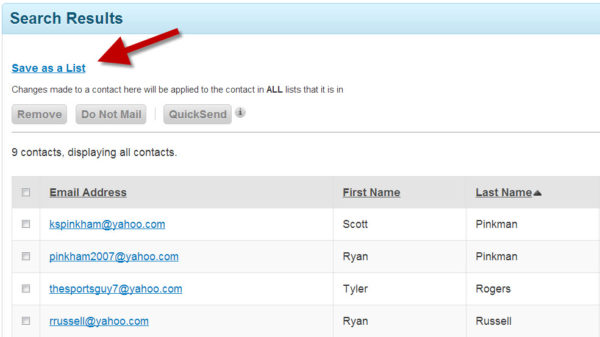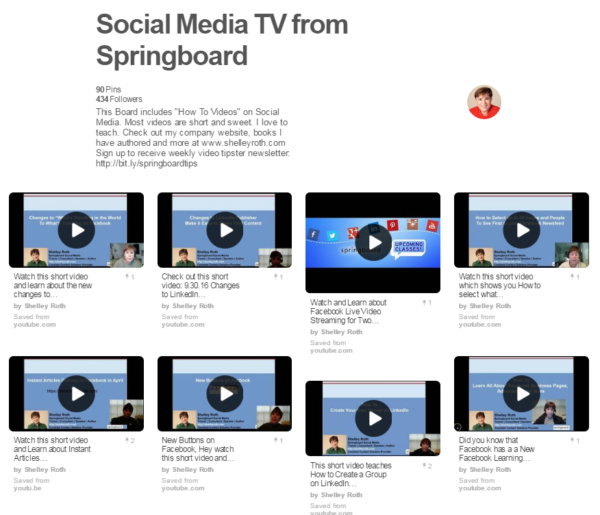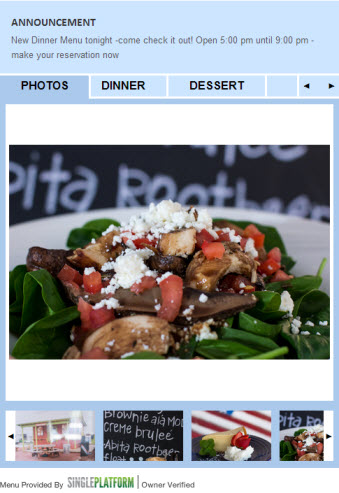We know that many small business owners are facing some frustrating setbacks when it comes to using Facebook to market their business.
To help them, we’re answering the top 5 frequently asked Facebook marketing questions we hear from small businesses.
If you’re facing some challenges too, we hope these answers can help!
1. “How can we, as a business, “Like” another business’s Facebook Page?”
Liking another small business’s Facebook Page is a great way to build relationships and show support for other businesses in your area. It’s also a great way to stay up-to-date with what other businesses have going on, and it can help you identify partnership opportunities as well.
But as you may have already discovered, Liking another business’s Page as your business, not yourself, can be a little tricky.
To Like another Page as your business, click on the More button that’s located directly under the Page, and then select Like As Your Page. Click the dropdown feature to select which Page you want to Like this business Page.
2. “It seems like only some of my Facebook fans see my posts. Why does Facebook do this? Is there anything we can do about it?”
Facebook recognizes that each user has hundreds of connections to friends, family, and businesses on Facebook who are all regularly sharing content. In an effort to avoid overwhelming individuals with Facebook News Feed content that they believe people might skip anyway, Facebook introduced the News Feed Algorithm (formerly known as EdgeRank), to deliver the right content to the right people.
What that basically means is that just because you post something to your fans does not mean they will all see it. In fact, organic reach for brand Pages is estimated to be less than two percent. This may sound unfair, but the News Feed Algorithm actually makes your (and your fans’) experience on Facebook more enjoyable.
One thing you can do to increase your chances of being seen in the News Feed is to use video. Facebook has placed a huge emphasis on video content, especially video using the Facebook Live livestreaming feature. Facebook gives video content priority.
That being said, there are things you can do to make sure your message gets in front of the right people. Here are a few resources to help you do it:
- 10 Lessons We Learned from Our First Facebook Live
- 3 Ideas for Your First Facebook Live Video
- How Facebook Decides if Your Posts Are Naughty or Nice
- Find the Best Time to Post on Facebook with New Page Insights
3. “Is it possible to see who is actually ‘checking in’ at our business on Facebook?”
Check-ins are important to getting your business found on Facebook. When a user checks in to a business or includes the business as a location in a Facebook post, their friends will see that activity in the News Feed or on the business’ Page. The more people checking in, the more opportunities you’ll have to be discovered by other Facebook users.
Unfortunately, you can’t see who is actually checking in at your business.
What Facebook will show you on your business Page is the number of people who are checking in over time. While this might not be exactly what you’re looking for, it is helpful to see which days, weeks, or months you’re seeing the most people checking in. It will also give you some insight into how your Facebook activities coincide with these numbers.
To access checkin data, go into your Page and click Insights at the top of your Admin Panel.
Under “Local,” you will find a section called “People Nearby.” Click on Check-ins to see how many people have checked in to your location in the last 30 days.
4. “I don’t understand engagement rate. Some posts receive a ton of clicks, but Facebook tells me that not as many people ‘saw it.’ Why does this happen?”
The Engagement Rate Metric makes understanding the success of a post quicker than ever. Facebook calculates the official engagement rate as follows:
Engagement Rate = Number of Clicks, Likes, Shares, and Comments/Number of people who saw the post (Reach).
The outcome illustrates the portion of your audience that is engaged with your content, consequently indicating the quality and success of your posts. Facebook will use this data to determine how many fans see future content you share on the site.
For example, if one post is reaching a significant amount of people, but not producing much engagement, the News Feed Algorithm marks the post as low quality. Too many low quality posts hurt your chances of appearing in your fans News Feed in the future.
Bottom Line: When you focus on providing content that’s relevant, interesting, and entertaining for your target audience, you should see engagement rate go up. While you will also want to test different types of content (photos, videos, links, text-only, etc.), what’s most important is that your audience is paying attention and engaging (Liking, using Facebook Reactions, commenting, sharing) the stuff you put out.
5. “Is it possible to merge multiple Facebook Pages? I have two pages that I want to combine, but I’m worried about losing all the work I’ve done so far.”
For a lot of small businesses, getting started on Facebook isn’t always a clean process. As a result, many small businesses unintentionally end up managing multiple pages.
If you’re an admin for multiple pages, Facebook has a pretty simple solution. Go to the top of the page you want to keep and click Settings. (Make sure you are using Facebook as yourself, not your business.)
Select “Merge Pages” and click “Request to merge duplicate Pages.”
Facebook will combine all of your Likes and check-ins, but will permanently remove all of the other content (posts, photos, and username) from the page you merge. The page that you want to keep will not change, except the addition of new Likes and check-ins.
If you are not already the admin for both pages, you will have to first verify that the page belongs to your business by requesting to claim the page on Facebook. Once you do that, you should be able to merge with your existing Facebook Page.
Still need to convert your Facebook Profile to a Facebook Page? Here’s help.
Have additional social media questions?
Check out our marketing resources page for social media tips and best practices. You’ll find blog posts, videos, infographics, Slideshares, and more. If you have other social media questions or want to learn more about any of the questions answered above, post them in the comments below!
For a lot of small business owners, social media is used primarily for marketing purposes.
Maybe you’re not interested in using Facebook or Twitter in your personal life, or maybe you just don’t have the time to spend on LinkedIn or Pinterest.
But while you may not want to use these sites in your personal life, you don’t want to limit your potential to reach new customers or clients because you are not using social media to market your business.
This brings up the big question, “Do I need a personal profile to create a Facebook, Twitter, LinkedIn, or Pinterest Page for my Business?”
Here’s what you need to know:
Yes. You will need a personal profile to create a Facebook Page.
Facebook wants everyone on the platform to be using the site as an individual, not just as a brand. This doesn’t mean you need to actively use your Facebook Profile or that your Facebook friends need to see all of your activity on your Facebook Page.
By creating a Facebook Page you will automatically separate your business activity from your personal interactions.
“Can’t I just use my profile to market my page?”
No. By using a profile for marketing purposes, you are violating Facebook’s Statement of Rights and Responsibilities.
But more importantly, if you’re not using a page, you won’t have access to Facebook Insights or other tools Facebook created specifically for businesses on the site. You will also limit your potential to build relationships with people who want to show support for your business by becoming a Facebook Fan, not a friend on Facebook.
If you’re already using a Facebook Profile to market your business, you can convert your profile to a page in a few easy steps! Here’s how.
No. You do not need to create a personal Twitter handle before creating an account for your business.
Twitter does not differentiate between the different “types” of Twitter users. All you’ll need to do is make sure you’re using a Twitter handle that reflects your business and that you’re filling out the right information.
If you do decide to use Twitter for personal reasons as well, you’ll want to create a separate Twitter handle. This is especially true if you plan to share content or participate in conversations that are not relevant to your business’s target audience.
New to Twitter? Here are a few tips to help you get started.
No. You do not need to create a personal Pinterest Profile to create a Pinterest Business Page.
To set up a new business account go to Pinterest.com/business/create.
“What if I already have a personal profile?”
Not to worry. If you already have a personal page, you can convert it to a business page as well. Similar to Facebook, there are a number of marketing benefits associated with making the switch to a Pinterest Business Page, including access to Pinterest Analytics and other tools to promote your business.
If you do want to use Pinterest as an individual, you may want to create a separate profile that’s not directly associated with your business. This will help you avoid having potential customers or clients seeing your personal activity on the site.
New to Pinterest? Here are a few tips to help you get started.
Yes. You will need a personal profile in order to create a LinkedIn Company Page.
And this is actually good news for small businesses. As a business owner, you will want to have a personal profile to help build your own professional relationships. You can connect with other local business owners and join LinkedIn Groups to build relationships within your industry. You can even follow other Company Pages to learn how businesses and organizations are using the platform for marketing purposes.
“Do I really need a Company Page?”
While a profile lets you tell your story, a Company Page lets you tell your business’s story. You can highlight your products and services, engage with followers, and even post job openings to help you find your next successful employee.
When your Company Page is set up, you will be able to link your personal profile to your page by editing “Experience” in your profile. You can also encourage your employees to do the same.
LinkedIn also offers its own analytics dashboard that’s exclusive to Company Pages.
To set up your Company Page go to Work> Create a Company Page.
New to LinkedIn? Here are a few tips to help you get started.
Managing your personal and professional social media presence
The bottom line is that whether or not you have an interest in using social media yourself, the people who matter most to your business are on these sites and they’re waiting for you to be there.
When you are ready to try any of these social networks, make sure you’re using the right type of pages to market your business. This will help separate your personal and professional activity, and will open you up to new opportunities to generate results from your social media marketing.
We recently held our advanced social media webinar and received a ton of questions from attendees! If you missed the webinar, you can order it on-demand here.
You’ve listened to all of the buzz about how great Pinterest can be for your small business, and took it upon yourself to set up your very own Pinterest Page.
You may have even gone as far as to post your first board!
Job well done.
But now what?
Tell everyone about it! Here are six ways to promote your new Pinterest Page:
1. Spread the word.
Leverage all of the social channels you currently use to tell your friends, family, and customers about your new Pinterest Page. Also, be sure to include visually-enticing pins from some of your favorite boards within your posts to really get people’s attention. If you have a business blog, you can actually embed a pin or an entire board using Pinterest’s widget builder too. This is a great way to drive people to your page.
You’ll also want to take your efforts offline as well. Just because Pinterest is an online social network doesn’t mean that you shouldn’t promote your Pinterest Page within all of your print marketing materials, including business cards, menus, flyers, signs, t-shirts — anywhere it can be visible. Tell every customer who walks through your doors about it. This is all part of getting the word out.
2. Use hashtags.
Yes that’s right. Similar to Twitter, Pinterest has a tagging system using the same hashtag method. Use hashtags in the descriptions of your pins so that even more people can find them. It’s a great way to have your Pinterest account and pins discovered by people searching through related content. Keep in mind that the people who find these pins will be very interested in them too because of the way they found them.
3. Send out a special email.
Create an email specifically dedicated to encouraging your customers to follow your boards on Pinterest. By doing so, you’ll be able to tell all of your customers about your new page quickly and they can start following you straight from that email. Remember to include some great images in there also. Afterall, Pinterest is all about the visual appeal.
4. Link to your website.
80.5 percent of small business websites do not link to social media networks.
Don’t make this common mistake. Not connecting your website to your social networks is a bad practice for all social networks, and especially for Pinterest. Adding a Pinterest logo to your website will not only help drive traffic to your page, but will act as a reminder to people who visit your website to pin your content.
5. Follow other businesses.
The nature of Pinterest is based on collaboration. Find other local businesses in your area to engage with and stay updated on what your customers are pinning alongside items from your business. Also, look to other businesses similar to yours on Pinterest for inspiration.
6. Make it easy for people to find you.
Update your “Search Privacy” to allow your boards and profile to appear in search engine results. Be sure you fill out the description sections of your boards and pins so that users searching can find you too.
Feeling like you need a few more Pinterest resources?
No worries! We have you covered.
Here’s a helpful guide about how to drive social visibility and new business with Pinterest.
It’s also good to know what not to do on Pinterest to avoid looking dumb.
Other than that, have some fun! Happy pinning!
If you have any additional questions about promoting your Pinterest Page, feel free to leave them below.
Facebook constantly tweaks its News Feed Algorithm, which determines the posts users see in the news feed.
In an effort to compete as a “news discovery platform,” the newest update to the Facebook News Feed Algorithm helps deliver more relevant news to its users, especially to users on the go, accessing Facebook from their mobile device.
Facebook News Feed Algorithm update recap:
- More links will be displayed within the news feed, especially on mobile.
- Links that are commented on by friends will receive a bump in the news feed.
- Memes hosted outside of Facebook will receive a decrease in the news feed.
Facebook reported that they’ve seen a 170 percent increase in traffic from Facebook to media sites over the last year. This significant spike has led Facebook to conclude that its users want to discover and consume more quality news within the platform.
How will they do this?
Facebook will look first at link clicks to determine the quality of a link, and second at the total of comments. Quality links will be “bumped” up in the news feed and will be more likely to appear to relevant users.
The more clicks and comments on a shared link, the more prominently it will appear in the news feed.
How do I know if my link is being clicked?
Don’t get discouraged if a link appears to be getting very little engagement, it could be getting a significant amount of clicks! To view the clicks on a link, open up the “Post” tab within Facebook Insights.
Check to make sure the engagement option that displays clicks has been checked.

Next, you can sort the posts based on the number of clicks each post received.

By clicking on an individual post, a “Post Details” box will pop up. Here you can view the number of clicks easily. Clicking to view a photo (in a photo post) is considered a click, so make sure you’re focusing on the “link clicks.”
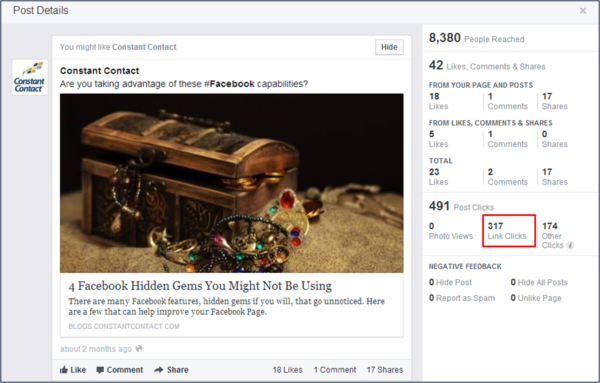
What if I already share quality links from my Facebook Page?
The Facebook News Feed Algorithm update will serve as a great opportunity for content developing businesses that create publications or blog content and you won’t need to change much. Try to encourage your fans to share their opinion on the article or ask a question related to the post to increase comments and give your link an extra boost.
Tip: Check to make sure the link you’re sharing is mobile friendly. Facebook is putting a greater emphasize on link clicks that occur in mobile.
What if I focus on sharing photos from my Facebook Page?
There is a chance the reach of your photos may be negatively impacted by the increased weight Facebook will now place on links. I suggest trying to rotate in a few links to articles within your content calendar and see how your audience reacts. Avoid linking to memes and encourage your fans to comment on your link by asking a simple but intriguing question relevant to the article.
Don’t stress too much, ultimately “quality” content is the most engaged with content. If photos still receive the most engagement on your page, in the end they will receive the most exposure.
Tip: Optimize the image that appears with the link you’re sharing. When you’re creating a link post on Facebook, the hyperlink pulls in the images from the post, so be sure to scroll through the images to choose which is the most eye catching. Don’t forget to also delete the hyperlink after the link preview is pulled into the post.
Recently, Facebook added the ability to upload your own image in a link post. I recommend uploading your own image at the Facebook recommended size of 1200×627 (appears as 400×209 in the news feed) or an image ratio of 1.91.:1. Links with larger images receive at least sixty-nine percent more link clicks. You can use Aviary or PicMonkey to create or crop images to the appropriate size.
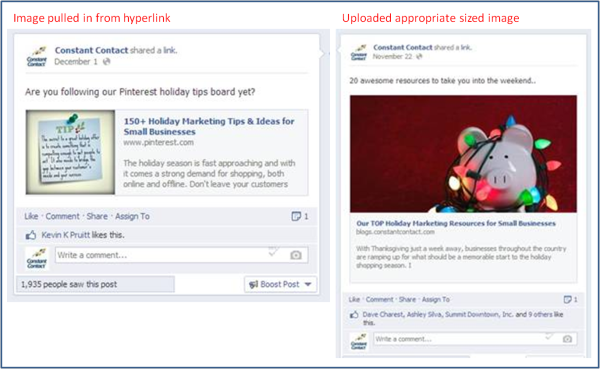
Personally, I was a little surprised by this update from Facebook. Contradictory to the statistics, my opinion has always been that people don’t look to Facebook to get their news.
The intention of Facebook users is to connect and converse with friends and brands in a more casual environment. Facebook wants to move away from displaying fun images such as memes, yet fun images when used appropriately, are the most engaged with content. Social media has also become increasingly visual across all social networks, including Facebook.
It will be interesting to see how Facebook users’ behavior changes.
Have additional questions about optimizing links for Facebook? Ask me in the comments below.
You may have heard (or maybe seen) that pictures can drive big engagement on Facebook.
It’s true. According to Facebook, images receive 120 percent more engagement than text-only posts.
This is great news for any small business that’s been struggling to get people to like, comment, or share, but also introduces a whole new question: How can I use images in my Facebook marketing?
I’m glad you asked!
This year, we’ve seen a ton of awesome examples from real small businesses and nonprofits that are using images on Facebook and getting great results. And what better way to discover new ways to use images on your Facebook Page than to look to other great local businesses and organizations for inspiration?
Here are 35 awesome examples:
1. Go behind the scenes
Most of your customers will only see the final product when they shop in your store or order online. Give fans a peek behind the curtains with images that show all of the work that goes into the products you sell and the services you provide.
2. Celebrate a milestone
When you achieve a milestone for your business or organization, you know that your customers played an important role in helping you get there. Let them join in on the celebration by sharing an image that celebrates your success.
3. Complain without complaining
Avoid using Facebook as a place to vent your frustrations (there’s enough of that on Facebook already)! Instead, get creative and look for opportunities to use funny images or sayings that vent without really venting.
4. Spark a conversation
Any time you can, look for ways to engage your fans in a conversation. You can use an image to catch their attention and text to encourage a response.
5. Celebrate your customers
Celebrating your customers builds strong relationships and markets your products and services in a whole new way. You can also tag your customers in your photos and thank them for stopping by.
6. Show yourself doing what you love
One of the things that makes small businesses, small businesses is the passion you have for the work that you do. Use photos to show your passion whenever you can.
7. Help potential customers envision your products
Instead of just using a stock image of a particular product, look for opportunities to offer fans a different perspective on the items you sell.
8. Show fans what they missed
Next time you have an event, make sure to take plenty of photos. You can then share those photos on Facebook and give attendees the opportunity to tag themselves after the event. For people who missed the event, photos offer a big incentive to put future events on their calendar.
9. Fill seats last minute
Another way you can use images on Facebook to promote your events is to fill last-minute openings. Snap a photo on the day of the event, share it with your fans, and let them know that there are a limited number of seats still available.
10. Give fans a new perspective
There are some perspectives your customers will never get the chance to see. When they see it on Facebook, there’s a good chance they’ll stop and pay attention.
11. Share some fun ideas
Showing your customers how to do something fun and new is a great way to build relationships online. Chances are their friends and family will want to know where they got the idea, which will help you attract new fans and customers too.
12. Help support a good cause
People like to spend money with businesses that share the same values and support the same causes. They also like to share information regarding those values and causes. Images will be sure to inspire your fans to get involved.
13. Get people excited for the future
As a business owner, you’re always looking towards the future. Make sure your customers are too! By getting people excited today, you’ll have more chances to grow your business tomorrow.
14. Show people your menu
Even text-heavy images can be useful on Facebook. When appropriate, share your menu or specials on Facebook with a great-looking image.
15. Show off your accolades
Don’t be modest! If you receive a great piece of coverage or an endorsement from an influencer in your industry, share it with your fans on Facebook.
16. Share your favorite quotes
People love quotes that inspire them and catch their attention. Consider using a tool like Aviary to add text to images and share them with your fans.
17. Drive people to your blog
If you manage a blog for your business, you know that generating traffic to your content can often be a challenge. If you haven’t already, try to use a fun and engaging photo to encourage people to click-through.
18. Encourage people to share the love
There’s a reason why the people who” Like” your Facebook Page are known as fans. These are the people who know your business, appreciate the work that you do, and are happy to show their support. Encouraging them to show the love on sites like Yelp or Urban Spoon can have a big impact when it comes to boosting your online reputation and bringing new customers to your business.
19. Demonstrate your shared values
One of the biggest advantages social media has for small businesses and nonprofits is that you can build a community around your organization. One of the best ways to build that community is to demonstrate your shared values to members of your target audience.
20. Support local businesses
If you run a small business, you know how important local support can be. Look for opportunities to build relationships with other local vendors by showing them off to your own network of fans.
21. Give fans a glimpse of the past
Whether you’ve been open for 10 months or 10 years, every business has a unique history and a story fans will appreciate. Sharing old photos tells your business’s story and gives people a glimpse into just how far you’ve come.
You might not have a history that dates back more than 100 years like Westover School, which posts pictures from the school’s archives every week on “Flashback Friday,” but chances are you have photos from your early days that customers would love to see.
22. Promote your latest newsletter
Sharing your email newsletters and announcements on Facebook attracts more readers and hopefully gets more Facebook fans to join your email list.
Make sure to use an image that will not only get people’s attention, but that will also give some indication of what they’ll find when they click to read.
23. Make people hungry
If you’re a restaurant, bakery, or caterer, using pictures to show off all of the great stuff coming out of your kitchen is sure to boost engagement. It’s also a great way to turn fans into customers and fast.
Even if you’re not in the food-service industry, the idea here is to make sure to choose photos that portray your products in a flattering light, and give customers some insight into how they came to be.
24. Show what people can do with your products
When you’re a fabric store like The Calico House, there are endless possibilities of what customers can create with the stuff you sell.
Showing customers some examples of how they can use your products will inspire your audience and can often generate quite a conversation.
25. Make people feel welcome
Chances are you’re already putting a lot of effort into attracting new fans to your page. But have you put any thought into how you’re going to thank people for becoming fans or make them feel welcome? Images offer a subtle way to do both.
26. Motivate your fans
Everyone can use a little motivation, especially on Monday mornings. Look to create images that inspire your audience and encourage them to get the most from their day.
27. Have some fun
Don’t forget, Facebook is supposed to be fun for you and more importantly for your customers. A “caption this” or “fill in the blank” contest are both great ways to engage your fans and have some fun in the process.
28. Build your reputation
Pet lovers are among the most vocal members of any social media community, and showcasing pictures that make people say, “Awww…” is a great method for getting people to click “like.”
But for Oh to Be a Dog, it’s not just about cashing in on the “cute factor,” it’s also about showing other dog owners that they offer a range of pet-care services — and most importantly — that other pet-owners have trusted them to take care of their pets.
Using photos to build your reputation and to develop trust with prospective clients is something that all businesses, regardless of their industry, should cash in on.
29. Let people know you’re still open
As a small business owner, you know how debilitating inclement weather can be to your business. And while using pictures on Facebook won’t do much to control the weather, it will help you keep customers informed about how that weather is impacting your schedule.
30. Tap into current events
While there are certainly hot topics and current events you’ll want to avoid, events like Shark Week are a great chance to use photos to boost engagement on your Facebook Page.
Just make sure you’re staying true to your brand and keeping the interest of your fans in mind!
31. Say thanks
Don’t underestimate the power of a simple “thank you.” Add a photo of your staff to provide a more personal touch.
32. Help get people through your door
“Sell! Sell! Sell!” isn’t a strategy that’s going to work on Facebook. If you want to get people off of Facebook and into your store, you need to provide a more personal touch.
Free treats and a relaxed shopping experience will work well, especially during the holidays.
33. Promote a special offer
Look for opportunities to get beyond text-only posts when promoting your offers and promotions.
Remember that people are on Facebook to connect with friends and to find stuff that’s interesting to them. Use a fun and engaging photo to catch their attention, and then provide the information they need to take advantage of your offer.
34. Share unfortunate news
It’s never fun when things go wrong. But when they do, it’s better to address the problem then to try and get around it.
Obviously if it’s something very serious, you won’t want to take things too lightly. But in some situations, the right image can be exactly what you need to keep fans happy.
35. Let people know where to find you
If you manufacture products that can be found in other locations, you can use Facebook to let people know where to find you.
If your products are available at other local retailers, you can tag the business in your Facebook post.
A picture could be worth more than ever in 2014
While images were already a huge part of Facebook and other social networks in 2013, you can expect these sites to get even more visual in the New Year. Luckily, with the popularity of smartphones, it’s never been easier to snap a photo, add a comment or a question, and upload it to your Facebook Page.
Use these examples as inspiration, and you’ll be well on your way to boosting your engagement and growing your Facebook Page.
Did you know you can now import your Facebook photos directly into your Constant Contact account? Learn more.

Shaun Brown, Canadian lawyer practicing at nNovation LLP and CASL expert.
CASL impacts Canadian marketers. And will also impact anyone marketing to Canadian consumers.
We have received many great questions from attendees who are using email marketing and other marketing tools to engage with their audience online.
We caught up with Shaun Brown, Canadian lawyer practicing at nNovation LLP and CASL expert, and asked him to provide guidance in response to the top questions we received about CASL.
Please note: The responses to these questions should not be considered legal advice. Please seek legal advice if you have any questions or concerns about how CASL may apply to your activities.
If I’m on social networking sites such as LinkedIn, Twitter, and Facebook: Is it considered express consent when people “like” or “follow” my page? Can I send messages to my fans (through the social platform or through email, or both)?
CASL establishes some specific requirements when requesting express consent for the purposes of sending a commercial electronic message (CEM). Senders need to ask for consent, and when they do, they must explain the purposes for requesting consent. A sender must also provide the prescribed identification information, and explain that recipients can unsubscribe in the future, as required by the Canadian Radio-television and Telecommunications Commission (CRTC) regulations. It seems unlikely that a “like” or “follow” could be characterized as meeting these specific requirements.
If I’m an exhibitor at an event: Can I collect business cards with the intention of building my contact list? Is the fishbowl method an acceptable form of obtaining consent?
I’ll address this in two parts.
First, it may be possible that the person collecting the business cards can rely on implied consent. CASL states that consent can be implied if:
- A recipient provides their electronic address directly to the sender.
- The recipient does not indicate that they do not wish to receive unsolicited commercial electronic messages.
- The commercial electronic message is related to the recipient’s business or official capacity.
It is arguable that the recipient is providing their electronic address directly to the sender when they put their business card in the fishbowl. Assuming this to be a proper interpretation of CASL, and assuming the recipient did not indicate that they do not wish to be contacted, then consent would be implied to send CEMs that are related to the recipient’s business or official capacity.
Second, it might be possible to obtain express consent. For example, a sender could post a sign next to the fishbowl stating that by entering a business card into the fishbowl, a user is providing express consent to receiving CEMs from the organization (not that exact language, but something that specifically describes what they are consenting to). The sign would also have to provide the prescribed identification information, and explain that they can unsubscribe in the future, as required by the CRTC regulations.
Without guidance and interpretation from regulators, we can’t say for certain that this is compliant with CASL. However, I personally do not see why it shouldn’t be. In my view, reaching into your pocket, pulling out a business card, and physically placing it in a fishbowl is a very clear expression of consent, just as if not more so than checking a box on a web form.
Just don’t forget that CASL states that any person claiming to have consent bears the burden of proving it. This means that when entering the person into an email system, it will be important to record certain information for evidentiary purposes, such as when and how the email address was collected.
If I’m a nonprofit: Are there specific regulations for me since I’m not selling anything?
CASL applies to any person who sends a CEM, regardless of who that person is. So, any organization that sends a CEM must comply with CASL. If the messages you are sending are not CEMs, according to this definition, then CASL does not apply.
A CEM is defined in CASL as:
An electronic message that, having regard to the content of the message, hyperlinks in the message to content on a website or other database, or the contact information contained in the message, it would be reasonable to conclude has as its purpose, or one of its purposes, to encourage participation in a commercial activity, including an electronic message that…
(a) offers to purchase, sell, barter or lease a product, goods, a service, land or an interest or right in land;
(b) offers to provide a business, investment or gaming opportunity;
(c) advertises or promotes anything referred to in paragraph (a) or (b); or
(d) promotes a person, including the public image of a person, as being a person who does anything referred to in any of paragraphs (a) to (c), or who intends to do so.
There are no exceptions or carve outs for nonprofit organizations, charities, etc.
That being said, there is a provision that allows organizations to send CEMs based on implied consent if there is an “existing non-business relationship.” An existing non-business relationship is deemed to arise where the sender: is a charity, political party or political candidate, and the recipient has volunteered, made a donation or given a gift within the previous two years; or is a club, association or volunteer organization of which the recipient has been a member within the previous two years.
It is worth noting that charities have raised concerns with Industry Canada regarding the potential impacts of CASL for fundraising. It is possible that we could see some allowances for charities in the final Industry Canada regulations.
If I already have an existing contact list: Do I have to reconfirm consent if I’ve been mailing to my contacts for years? How does “grandfathering” work?
It really isn’t possible to provide a simple or categorical answer to this question beyond saying that you may decide that you need to reconfirm at least some of the contacts on your list. It really is fact and case specific.
There are a few considerations worth pointing out. Senders not only need to have consent, but they bear the burden of proving it. Thus, you may be required to provide evidence that you obtained consent in compliance with CASL to the CRTC, which is the enforcement agency under the legislation, if you are ever investigated for violating CASL.
Even if you do not have express consent, you may be able to rely on implied consent. For example, an existing business relationship arises if the recipient has made a purchase from you in the previous two years. Furthermore, there is a transitional provision in CASL, which effectively extends the time period for an existing business relationship to three years after the day on which CASL comes into force.
Senders need to review their lists and whether they have express or implied consent for existing contacts. If they don’t, then they may need to consider a reconfirmation strategy or face the risk of violating CASL.
There is no “grandfather” clause in CASL for existing consent. However, the CRTC recently stated that it would provide some allowances for pre-existing express consent obtained in compliance with Canadian privacy legislation, such as the Personal Information Protection and Electronic Documents Act. What the CRTC is really saying is that they are not going to enforce CASL against someone who has obtained consent that is consistent with the requirements of CASL, but may not have included all of the prescribed information required in the CRTC’s regulations. Note that this only applies to consent obtained before CASL.
There have also been requests that Industry Canada include some form of “grandfather” clause in its final regulations, which may be published this fall or winter. So, stay tuned to see whether Industry Canada provides any provision for grandfathering existing consent when its final regulations are published (they will be on my blog as soon as they come available).
There are a lot of social networks out there today, but the “big 4” are definitely the ones you hear about the most.
Below you will find a glossary of Facebook, Twitter, LinkedIn, and Pinterest terms. Hopefully, by the time you’re finished reading it, you will feel comfortable talking the talk and walking the walk on any of the big 4 networks.
Let’s get started:
 Profile – A personal page created for individual use.
Profile – A personal page created for individual use.
Page – This is your business profile or page where customers can find your posts and business information.
Page Like – When a fan likes your page, anything you post or update will show up in their news feed.
Activity Log – A log that shows you all of your scheduled content, as well as past content posted to your page.
Insights – This is your analytics hub. You can find all post and page analytics here.
Reach – The number of people who saw your post. This includes the number of people you reached through organic and paid reach.
Organic Reach – The number of people who saw your post.
Paid Reach – The number of people who saw your post due to an ad you paid for.
Engagement – The number of likes, Facebook Reactions, comments, and shares you receive.
Post Clicks – The number of people who clicked on anything in your post. This could include someone clicking on an image with a “see more” call to action or a URL you included.
Post – A term used for sharing content on your Facebook Page.
Text-Only Posts – A post without an image, video, or link.
Multimedia – A post that includes an image or video.
Link – A post that includes a URL.
Facebook Live – Facebook’s live streaming video feature.
News Feed – Your news feed is the first thing you see when you log in to Facebook. The feed shows new posts from pages and profiles you’ve liked.
Timeline – The stream of updates on your own personal profile or page.
Profile Picture – The image that represents you or your business. This is the smaller photo that shows up alongside all of your posts.
Cover Photo – The 820 x 312-pixel image found at the top of your page or profile.
Like – An engagement function that lets fans give positive feedback on a post.
Comment – This one is self-explanatory!
Share – The share feature lets you share the content you enjoy with personal Facebook friends.
Facebook Reactions – An extension of Facebook’s Like button. There are six reactions: Like, Love, Haha, Wow, Sad, and Angry.
Messenger – A private message.
Tabs – These are found underneath your profile photo and are links to information on your business, location, photos, videos, and third-party apps you have.
Events – Facebook Events can be created by a page or profile, and are used for parties, business events, and planned chats.
Group – This can be public or private, and gives users the chance to come together to talk about a specific subject in one place.
Friends – A friend is someone who received your friend request from your personal profile and accepted it. Once the request is accepted, you will start seeing their updates in your news feed.
Fans – These are the people who liked your business page. A business does not have to take any action for someone to become a fan.
Sponsored Story – This is a message that comes from a friend about them engaging with a page, app, or event that a business, organization, or individual has paid to highlight.
Promoted Post or Boost – You can pay to boost a specific post so that it is shown to more friends or fans.
Display Ad – An ad you create that is shown on the right-hand side of Facebook along with other ads.
Learn more about how to use Facebook for marketing.

Tweet – The content you share with your followers.
Handle – This is your “username” on Twitter that appears with an “@” symbol in front of it.
Hashtags – Although they were originally created and supported by Twitter, hashtags are now utilized on Facebook, Pinterest, Instagram, Vine, Google+, and Tumblr. A hashtag is a group of words or phrases (with no spaces), preceded by a # sign (i.e. #ONECON or #CCPin). It is used to tie various social media posts together and relate them to a topic. Topics are sometimes connected to an event, TV show, sporting event, or any happening or trend etc.
Reply – You can reply directly to a tweet. Only the people following you and the person you’re replying to can see your reply (unless you place a character before the handle at the beginning of the tweet).
Retweet – A way to repost or share someone else’s tweet.
Favorite – This functions just as a Facebook “like” does. You can also use this as a saving tool and go back to your favorites later.
Mention – The act of including someone’s handle in your tweet. That person will then get a notification that they’ve been mentioned.
Direct Message – This is the only way to talk to someone on Twitter privately. You can create these by either starting your tweet with “DM” or going to someone’s profile and using the “message” function.
Feed – This is the first thing you see when you log in to Twitter. New posts from your followers are placed in your feed.
Followers – These are the people who have followed your handle and can see your updates in their feed. You do not have to follow them in order for them to become your follower.
Following – These are the people you follow so you can see their updates in your feed. They do not have to follow you for you to be able to follow them.
Trends – The most commonly used hashtags at that present time are considered trends. They can also be made to pull from a specific location.
Lists – Groupings of your followers that you’ve created and categorized so that you can find them easily.
Connect – A tab where all mentions, replies, retweets, and favorites can be found.
Discover – A tab to search for hashtags, handles, and keywords.
Verified Account – This is used to establish authentic handles of key or public individuals and brands.
Here are 4 tips for how you can maximize your exposure on Twitter.
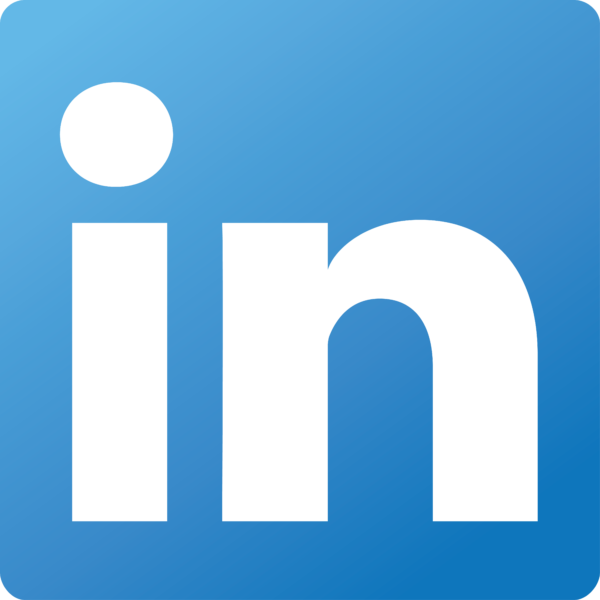
Update – Status updates and content that you post.
Profile – Similar to a resume, you add information about you and your job history.
Company Page – A place for businesses to include information about their business and create updates about their business and their industry.
Mention – Just like Facebook and Twitter, you can mention others in your LinkedIn updates.
Connection – An indicator that you and a person are connected to each other.
Degrees – This acts like 6 degrees of Kevin Bacon by showing you how you are connected to a person even if it’s through a number of people.
Invitation – Invite someone to join your network and connect with you.
Introduction – A way to introduce yourself to those you are not currently connected to.
Groups – These can be public or private, and can be created by an individual or company. It allows users to come together and talk about a specific subject on one page.
Network – Your connections which also includes the connections of your connections.
Recommendation – A way to recommend a friend/colleague, based on their professional experience, to anyone who views their profile.
Influencers – Key and influential people in your industry that can provide you with great content.
LinkedIn Today – A source for all of your industry news in one place.
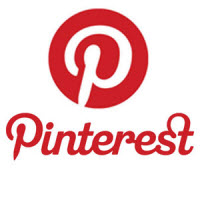
Pins – An image uploaded (“pinned”) from any webpage or your own computer to a Pinterest board. All pins link back to their original source, so make sure you choose the right webpage.
Pinner – The person behind the pins.
Repin – The act of sharing someone else’s pin.
“Like” – This functions just as a Facebook “like” or a Twitter “Favorite” does. It tells the pinner you enjoyed what they pinned.
Board – A grouping of pins under a category you’ve created. It allows you to organize your thoughts, images, and websites.
Mention – Just like on Twitter, Facebook, and LinkedIn, you can mention another pinner in a post. They will also get a notification about the pin.
Follow – The act of following other pinners or just a couple of their boards. They do not have to follow you back for you to be able to follow them.
Didn’t think you could look dumb on Pinterest? Here are 25 things to avoid
Want to learn more?
For more help with your social media marketing, sign up to receive our Hints & Tips newsletter. You can also explore other marketing terms and their meanings.
Instagram is the popular app known for the cool pictures you can take with it. But there’s a lot more to Instagram than meets the eye. Once you get past the cool pictures, you’ll see just how influential it can be for your business.
If you take a closer look, you’ll discover that Instagram could be your next great marketing tool.
And with the ever-growing population using this app, it’s something small businesses and nonprofits should explore.
Here are 3 benefits of using Instagram for your small business.
Benefit 1: Personal touch
When I say personal touch, I’m not referring to the color of your office walls or your pretty business cards. What I’m referring to is your personality outside of your business. Like many other small business owners, you may have emptied your savings, took a big risk or gave up an office job to do what you love. But most of your customers don’t know that about you.
Instagram gives you the perfect opportunity to show customers your personal side. By doing this you’ll not only make your business more personable, you’ll leave a lasting impression on current and future customers.
How?
Show your role in the business by giving your customers a behind-the-scenes peek at how you run things. This could be a picture of you in a meeting or a video of you playing a prank on a co-worker. These types of simple pictures and videos can be done in less than five minutes and will add a nice personal touch.
Benefit 2: New demographic
Instagram connects people from all over the world to one another through images. And once you start using it, you automatically open yourself up to a completely new demographic of people. For most small business owners, and of course depending on your target audience, this can only be a good thing.
Over 150 million people use Instagram, with 55 million photos being uploaded every day. Take advantage of this incredibly large, active network of people. Connect with potential prospects!
How?
It’s pretty easy. Simply download the app and start creating your presence on Instagram. Staying open to new connections and being active is the best way to interact with a new demographic.
Benefit 3: Network
It’s easy to get caught up in all those pretty pictures, but like I mentioned before, there is more to Instagram than the photos. Instagram is like any other social network, so use it to its fullest and network!
Social networks were created to help people meet new people and build relationships. Start interacting with a whole new network of interconnected people. In turn, you could gain followers, potential new customers, or new partners.
And it doesn’t end there. Instagram is connected to Facebook and Twitter. This makes it easy to connect all of your networks and use them interchangeably without too much stress.
How?
Like, comment, and follow others and you will begin to see your follower numbers rise. Once you connect Instagram with Facebook and Twitter, you can add to the friends and followers you already have. And remember, like any other social network, you have to stay active to continue to build your presence and maintain what you’ve already established.
So taking cool pics and videos can do all of the things above?
They do say a picture is worth a thousand words, right? Pictures tell stories and if used properly, can drive engagement. Instagram can be a powerful channel that allows you to show customers the personal side of your business, connect with new prospects, and network to create meaningful relationships. Pinterest is another great social media network that drives engagement through images.
Want to learn more?
For more help with your social media marketing, sign up to receive our Hints & Tips newsletter.
If you’re only using Twitter to promote your own content, you’re really missing out.
While it’s certainly good for that, it’s also a valuable discovery tool as well.
There are more than 500 million tweets sent on Twitter every single day. That’s a ton of information!
Luckily, Twitter makes it easy to navigate that information and find the stuff that’s actually relevant to you with Twitter search.
Here are 5 unexpected benefits of using Twitter search.
1. Find out what people are saying about you
A lot of Twitter users won’t take the time to track down your Twitter handle every time they’re talking about you or your business. This is especially true if someone is voicing a complaint or asking other Twitter users about your products or services. (Ex: @RyanPinkham: I’m looking for a good place to bring my dog during the day. I heard Paws at Play was good. Has anyone used them?)
To find out what people are saying about you, search for your name or your business name and any tweet containing those words will appear in your search stream. This will help you stay on top of those relevant conversations and ensure you never miss an opportunity to WOW! your customers or address a potential complaint.
2. Stay in touch with your community
One of my favorite hashtags to follow on Twitter is #GloucesterMA. It is the unofficial hashtag of my hometown, and is full of updates about local events and other happenings throughout the community.
For me, it’s the perfect way to stay up to date with everything that’s going on. For the businesses and organizations that participate in and follow this discussion, it’s the perfect resource for staying tuned in to everything happening in our corner of the world.
Try searching for a hashtag or term related to your local community. If you find one that’s actively being used, save it. If you don’t, try starting the conversation by using it when connecting with other local Twitter users.
3. Be on top of hot topics
Even if the majority of work you’re involved in happens on a local level, there are topics outside of your community that you’ll need to be aware of.
Maybe there’s a state or federal policy change that could directly impact members of your industry. Or maybe there are new trends in your field of work that you need to be on top of.
By saving a search related to a particular topic you are interested in, you will have instant access to the most up-to-date discussions that are already taking place. [Tweet this tip!]
4. Discover content inspiration
Coming up with great content is one of the biggest killers of small business marketing success.
That’s why it’s so important to always be on the lookout for new sources of content inspiration.
Twitter search offers an easy way to find content that’s relevant to your business from “content leaders” in your industry. Simply pick a topic or hashtag to follow, and you’ll have a stream of relevant content ideas all in one place.
5. Be smarter, better, more informed…
No matter what line of work you’re in, it’s important to always be looking for new opportunities to grow and make improvements.
If you’re reading this post, than there’s a good chance you’re interested in learning something new about Twitter or social media marketing.
But maybe marketing isn’t your biggest concern. Maybe you’re more interested in learning about time management or how to find the right employees. Maybe you want to run a better event or get more from your partnership agreements.
Whatever topic is on the top of your to-do list, Twitter search can help expose you to a number of valuable resources that can improve your results.
Expect the unexpected
When you start to think differently about how you approach sites like Twitter, Facebook, Pinterest, or LinkedIn — you’ll discover unexpected benefits you never knew existed.
For Twitter, that could mean finding a valuable new source of information that helps you run your business and improve your marketing results. New opportunities exist on other networks as well.
Want to learn more?
Stay on top of the all the latest social media and email marketing trends! Sign up for our Hints & Tips newsletter to get our best blog posts delivered to your inbox twice each month.
Word images are images with words on them. I know you’ve seen them before, because they’re everywhere.
On Facebook, word images inspire, encourage, and move people to take action.

On Pinterest, word images build desire and create clicks.

On Twitter, word images provoke laugh-out-loud moments.

Word images used to be exclusive creations of trained graphic designers. But now, with easy (and often free) tools like PicMonkey, everyone can create word images to promote their business.
And that’s usually a good thing.
But not always. If someone doesn’t know the basics of creating a successful word image, you’ll log on to Facebook and see something like this:
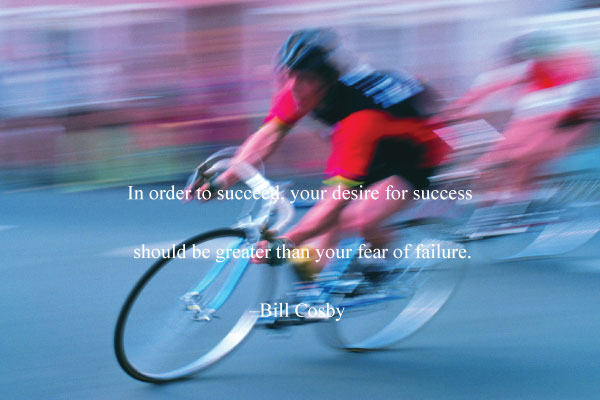
Not good. In fact, it’s a waste of time.
The person who created this word image wasted their time because it won’t get results.
And the person who saw this word image just lost a few seconds of their life trying to interpret an impossible-to-read image.
Today we’re going to talk about “word image disasters,” and you’ll learn how to avoid them. I’ll show you some sure-fire graphic tricks you can use to create word images that get results. Let’s get started!
Word Image Disaster #1: Too much text
Want to create a word image that makes people squint, rub their eyes, and contemplate ordering new glasses? Just load it up with too much text. Take a look:
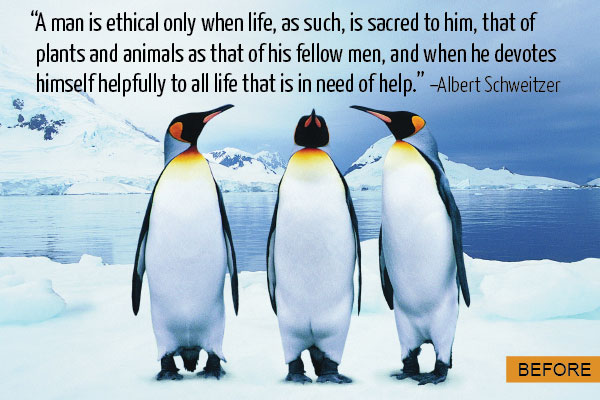
Here’s how to avoid this problem.
- Edit your message and keep it to no more than a sentence or two. Word images aren’t made for paragraphs of text.
- If you’re using a quote, take an excerpt of the quote instead. Use an ellipsis to indicate where you edited the quote. Just be careful not to alter the meaning of the quote. See the example below.
- If there’s not an easy way to edit the quote, simply find another quote that says something similar using fewer words.
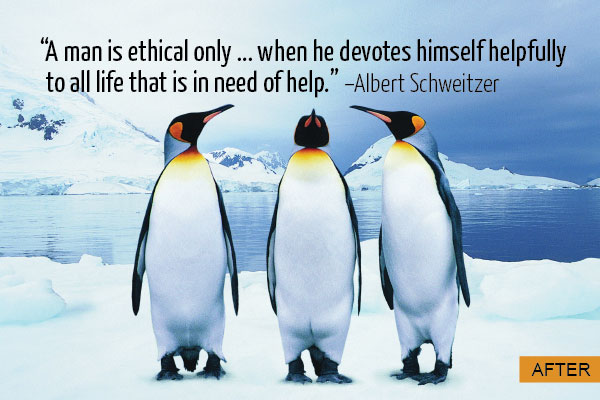
Word Image Disaster #2: Text placed over a busy area
The image you select is just as important as the text you add to it.
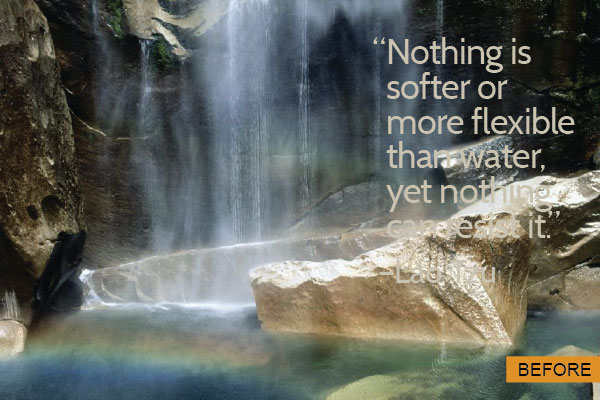
Choose images with areas that lend themselves to having text added. These should be low contrast, “smooth” sections of the image that aren’t visually busy.
If you have your heart set on a specific image and it doesn’t have an area that’s not busy, you still have a few options.
You can try adding a translucent box. To do this in PicMonkey, use the Overlay tool, and choose Geometric shapes. Choose a shape, apply a color, then move the Fade slider to make it translucent.
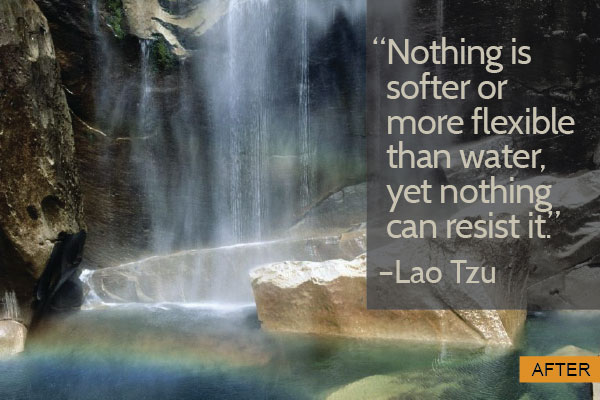
You could also add a colored bar at the top, bottom, or alongside the image:
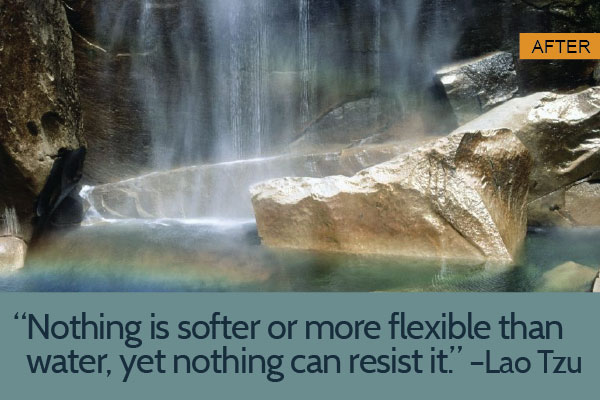
For a graphic look, add a geometric shape:
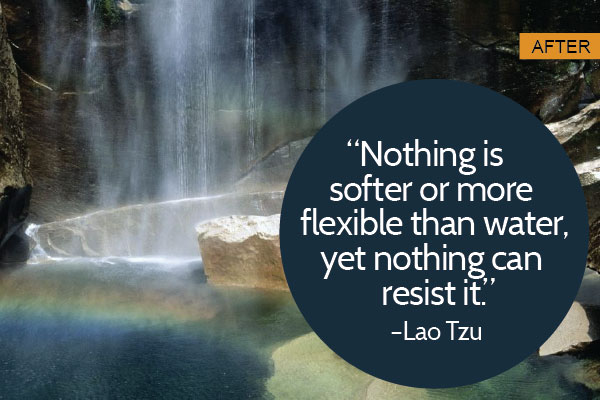
Or add a geometric shape and make it translucent. Fancy!
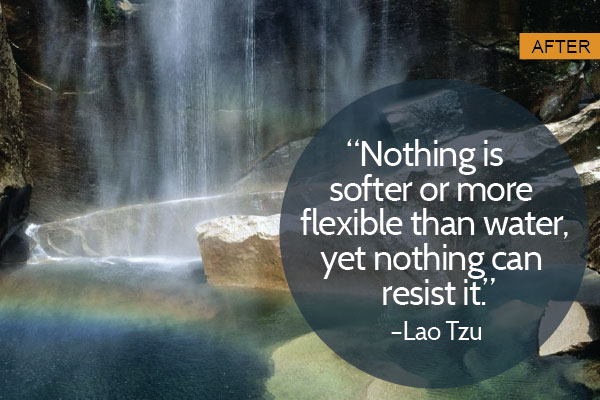
Word Image Disaster #3: Low contrast text that’s unreadable
Here’s another common problem. When you choose a text color, it’s important to select one that contrasts with the background you’re going to place the text over. Here’s an example of a word image disaster caused by low contrast text:
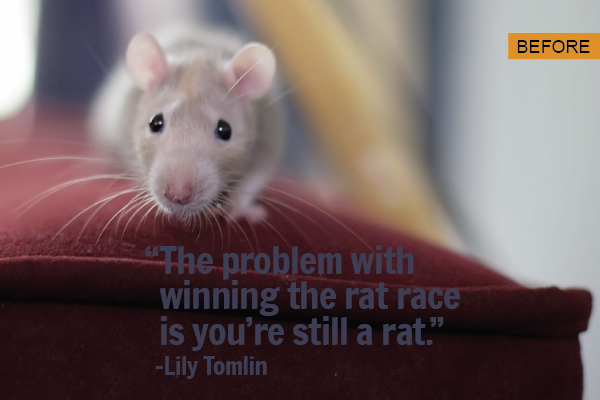
This problem is easily fixed by changing the text color to something that “pops” from the background.
How do you know what color will pop? Choose one from the opposite side of the color wheel.
 Green is opposite red on the color wheel, and since the background we’re placing the text on top of is a deep red, a deep green should work well. Here’s what our word image looks like when we use a color that contrasts better with the background:
Green is opposite red on the color wheel, and since the background we’re placing the text on top of is a deep red, a deep green should work well. Here’s what our word image looks like when we use a color that contrasts better with the background:
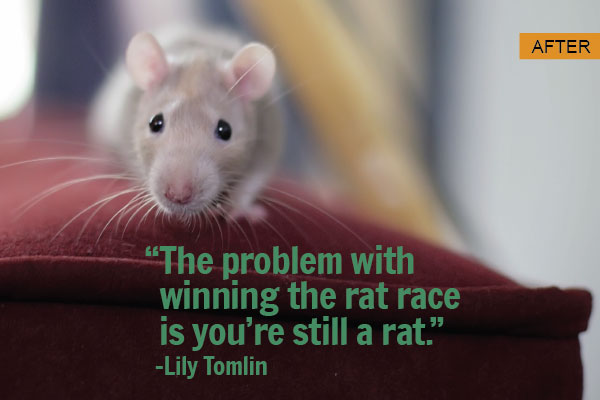
Word Image Disaster #4: Text is too small
Remember, your word image will be reduced in size when you post it on social media. Be careful that your once easy-to-read, larger-than-life text does not shrink down to something that’s squint-inducing after it’s posted:
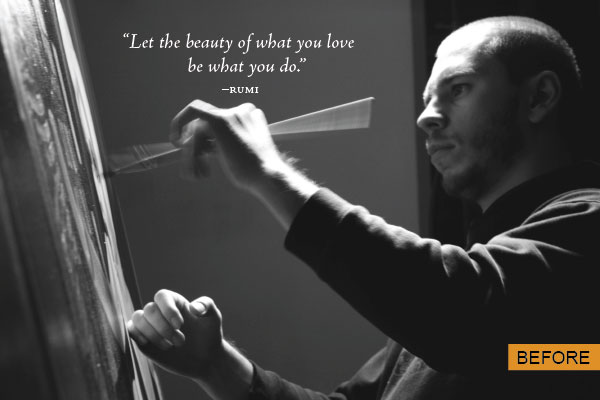
The solution here is to work at the actual size your final image will be so you can check readability as you go. After you put text on your image, reduce it to the final size and take a look to confirm that the font size you’re using holds up when reduced.
Font sizes vary widely, but a good rule of thumb is to use at least 36-point fonts if you’re working on an image that’s sized for social media sharing. Trust your eyes before the numbers, though.
Word Image Disaster #5: Bad font choice
You’ve seen word images like this, right?
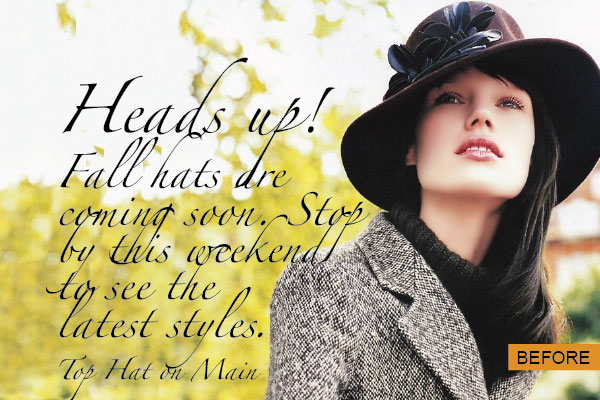
They’re almost impossible to read because the font doesn’t hold up to the background. That’s why LOLcats and all those humor sites use ALL CAP bold serif fonts: they hold up to almost anything.
Now, I’m not recommending you do that unless you’re trying to create a tongue-in-cheek image that looks like it belongs on LOLcats.
What you should do, though, is look for fonts that are heavy enough to hold up to having an image behind them. The image above would work with a font like this, for example:

Word Image Disaster #6: No call to action
If you’re lucky, your word image will be shared, commented on, and will show up in lots of people’s streams and feeds.
In order to trace it back to your business, make sure that the last step you do when creating a word image is to add a mention of your business somewhere on the image.
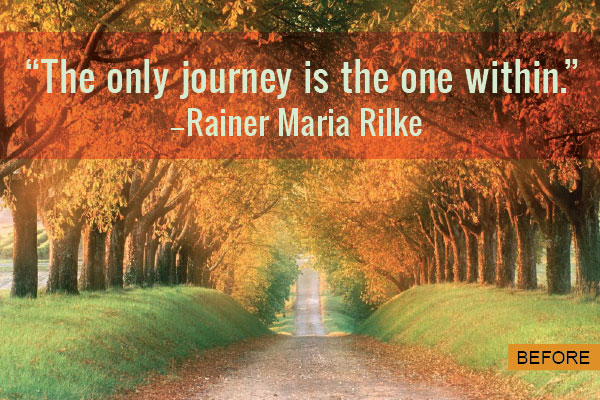
Use the same design tips I’ve shared here to add your website address where it will be seen, but won’t get in the way of the image. The bottom left or right corners are good places to try.
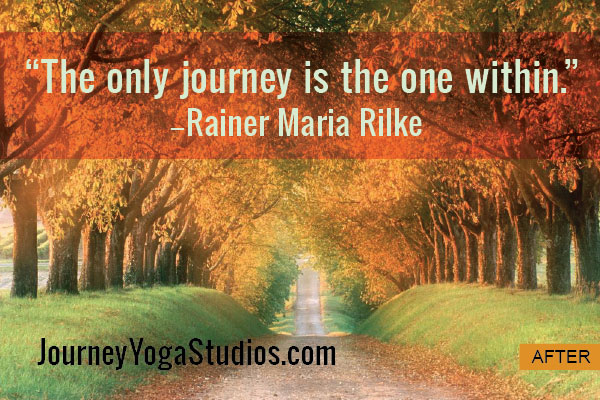
Want to learn more about creating marketing images? I have a free course I’d love to send you called the 12 Days of Visual Buzz.
Want more design tips? Check out our new Email Design Best Practice Guide.
Pinterest, a social media network that was invitation only until August 2012, is one of the hottest tools for small businesses and nonprofits. The trouble many small businesses and nonprofits face is figuring out how to utilize Pinterest to its fullest potential.
To make the most of this network, you must first understand what it is. So, what exactly is Pinterest? I’m glad you asked!
Pinterest is…
…a scrapbook or pinboard that allows you to “pin” websites and images that you like and want to refer back to later. It allows you to create categories or boards that organize your thoughts, images, and websites. According to Pinterest.com, “Pinterest is a virtual pinboard. Pinterest allows you to organize and share all the beautiful things you find on the web. You can browse pinboards created by other people to discover new things and get inspiration from people who share your interests.”
One of the best things about Pinterest is that everything you pin is clickable. This means that you can link to your website or to a registration page to drive traffic back to your assets. When you pin a link, Pinterest pulls all images from that specific page and you can choose which image you would like to represent your link.
Just remember, you do not want to drive traffic back to only your website. If you find a website or article that you like and think would apply to one of your boards, pin it. If you follow someone who pinned something you really liked, repin it! Pinterest is still a social network, so make sure to interact with followers by repining or commenting on their great pins.
Here are 7 Pinterest tips for nonprofits.
1. “Pin” your personality
Just as you would use Instagram for your nonprofit, one of the best ways to use an image platform is to show your volunteers/employees and your cause through imagery. Why? Pinterest drives three times more web traffic to other sites than Google+, Twitter, LinkedIn, YouTube, Reddit, and StumbleUpon combined.. I’m going to guess that you would appreciate some extra traffic to your website.
The best way to show your personality and increase web traffic is to pin the great images you take as well as background information on your website. Then, go to Pinterest, pin that specific page from your website, and select the image you want to show your audience.
Example: If you own a nonprofit pet shelter, create boards that link back to your adoptable pets, volunteers working with the animals, and behind-the-scenes photos.
2. Show your knowledge
You’re an expert in your field…embrace it! Create a board all about your field.
Example: Back to the nonprofit pet shelter, create a board that links to tips on how to groom your pet, make homemade treats, and best ways to house train your pet. These boards are most effective when they link to websites, articles, and pins from sources other than your own.
3. Let your hair down
Pinterest is a great place to let loose a little.
Do you love quotes? Hint: Most people do. Create a Pinterest board with your favorite quotes and sayings.
Did you and your volunteers go on a fun field trip? Upload the images you took and show your followers the fun side of your nonprofit.
4. Follow the pinner
Don’t forget to follow like-minded pinners and follow back the like-minded pinners who follow you! You can get a lot of inspiration from other nonprofits who use Pinterest.
Begin to grow those relationships by sharing (or repining) their pins in the appropriate boards.
5. Share the love
Pinterest allows you to share your knowledge, images, and website with others all in one place. This is a HUGE advantage for nonprofits. One of the most important parts of being a nonprofit is building your relationships.
Create a board for “Nonprofits Doing it Right” or “Nonprofit Tips and Best Practices” and pin information you find from other nonprofits. These pins could be about an event a nonprofit is holding or a page all about their volunteers.
Constant Contact has a board for “Nonprofit Tips and Best Practices.” This board is geared towards marketing education, but your board can go in many different directions. Check it out below.
6. Raise money
That’s right! You can raise money on Pinterest! Pinterest makes it really easy for you to hold an auction or sell a fundraising item on Pinterest. Simply add a “$” with the price amount in the description section of your pin and Pinterest will automatically add a grey banner in the top-left corner of the image that will display the cost. The item will also be added to the “Gifts” tab on the Pinterest homepage.
7. Connect the dots
Just like any other social network, you want to make sure you connect the dots by including the Pinterest logo anywhere your customers/volunteers/donators will see it. You can find the Pinterest Widget Builder here. Using this page, you can also embed an entire board into your blog!
Make sure to include a Pinterest button within your:
- Email signature
- Email newsletter
- Website
- Signage at events and in the office
There are so many ways to effectively use this fantastic tool. A great way to start is to see how other nonprofits are using Pinterest. At the end of the day, why wouldn’t you want to use a tool that will help build relationships and drive traffic to your website? So get out there, follow some great new pinners, and get your feet wet.
Happy pinning!
If you have questions about Pinterest, let me know in the comments below. I’d love to hear from you.
The acronym S.W.A.L.K (sealed with a loving kiss), originated during WWII. Servicemen would write to their sweethearts at home, ending each love letter with this sign off.
Fast forward 70 years and this sign off is still perfect in every way. Now, I’m not recommending that you send loving kisses to all your customers, but I do recommend that you make your email newsletter sign offs personal. More on that matter…
Every time I get up in front of a room full of people to talk about marketing, I emphasize how important it is to make sure that your communications:
- Feel like they come from you
- Are authentic to the personality of your business
- Speak directly to one person (people read your message by themselves)
All of these things will help you get a much better response from your audience when you send your newsletters out. However, one of the best ways to help your readers identify more closely with you and your business is to have a great sign off. A great sign off is really, really, easy to create too. Here’s how:
1. Include your contact information.
This is about practicality and trust. First and foremost, you want people to contact you so that they can ask questions and place orders. That’s how we get customers, right? Secondly, if you share your contact information with your readers, it tells them that you trust they won’t abuse it. As we all prefer to buy from people that we know, like, and trust, giving out your contact information makes them trust you even more too.
2. Use a hand-written signature.
Nobody wants to feel like they’re getting messages from a robot. Consider adding a .jpg (picture) of your scanned signature to your newsletter sign off. This will give it a professional and personal touch. Warning: Don’t scan your full signature, only scan your first name. You don’t want people using it to impersonate you in any way.
3. Add social media links.
You want your readers to connect with you in as many places as possible. Share your social links in your emails and invite them to say “hello” and become a fan/follower. Ultimately, the more points of connection you have with a person, the more likely they are to buy from you and recommend you to others because you’re building up the “trust factor.” It additionally means that if they miss a message of yours in one place (Facebook), they may pick it up in another (Twitter).
4. Show your face.
Put a headshot of you in your signature. This makes the reader feel like they’re having a personal conversation rather than reading a marketing email. People like to know who is behind the newsletter. This can also help reduce unsubscribes if you’ve personally met people at an event because they’ll see your face and remember who you are.
Bonus tip:
5. Present a powerful P.S. to drive action
A good P.S. in bold and italics, just below your signature, is a powerful call to action. Why? Most of us “scan” our emails rather than read them all the way through. You want to grab their attention with a strong, engaging call to action. Our eyes are naturally drawn to different text (that’s why we use bold italics), and a P.S. is always intriguing. Try it and compare your click throughs. It should get the most clicks!
If you can do all of this (and you should, it’s not hard), you’ll create a better connection with your readers and have an improved response to your newsletters.
Want more helpful information about improving your newsletters? Check these out.
- 5 Things Customers Need to Hear You Say in Your Email Newsletter
- 3 Tips on How to Keep Your Email Newsletter Content Short
I would love to know if any of these pointers improve your click throughs. Let me know how it goes in the comments below.
Did you know the brain is able to process visuals 60,000 times faster than text?
The days of text-heavy newsletters or marketing content are long gone. Today, consumers are overwhelmed with content and limited on time. Make your messages stand out by embracing visual content. Your subscribers or social media fans may not have time to read a lengthy message, but you can still make an impression through visuals.
A picture isn’t just worth a 1,000 words, it’s worth a whole lot of engagement
Hands down, people are more likely to engage with visual content than text-heavy content. Photos on Facebook receive 120 percent more engagement than the average post, tweets with images are twice as likely to be engaged with, and using images in your newsletter can help boost your open rate. Even when your fans don’t engage with you, images allow them to process your content with a quick scan. Fortunately, small business owners don’t need to invest in expensive equipment or hire a professional to embrace this content marketing strategy. The tool you need is right in your back pocket.
Easy as 1, 2, 3
Using your smartphone to create visual marketing content is not only effective but it’s easy because you already carry your smartphone around with you wherever you go. It’s as simple as point, click, upload to Facebook, Twitter or Instagram, add a caption, and press send. When it’s time to create your next newsletter, revisit your saved photos and select your favorites to incorporate into your messaging.
By showing off some behind the scenes action, you can humanize your brand and build genuine relationships. Don’t worry about finding the best angle or perfect lighting either. Photos that capture “real” moments aren’t perfect and your audience knows that.
Moments you can capture
- Your employees in action
- The production of your product/s
- Customers enjoying your product or services
- A sneak peak of a new product
- New displays or decorations in your store
- Events
- Company milestones
The possibilities are endless!
Think of your visual marketing strategy as a way to tell your brand’s story. The photos your subscribers and fans will be most interested in capture the authentic moments in the everyday life of your business.
Advanced smartphone photography
If you want to take your smartphone camera skills to the next level, there are plenty of great free apps that you can download. Here are a few:
Pic Stich and Pic Collage: Both great for making beautiful collages.
Photo Editor by Aviary: Edit and add frames, text, filters, stickers, etc.
Panorama Free: Capture more with a panoramic image.
Fisheye and Color Effects: Get creative and have fun with color.
Glyder, an app featured in the Constant Contact MarketPlace, lets you create marketing messages on your iPhone that you can send to your Constant Contact lists, Facebook, Twitter, Pinterest, Apple Passbook, and Address Book contacts.
A personal favorite of mine is Camera+. It costs $1.99, but it makes it easy to take photos that look like they were shot on a professional camera.
If you haven’t been using your smartphone to create marketing content, it may take a little getting used to. But once you get in the habit of pulling out your smartphone to snap great photos, you’ll be glad you did. Using your smartphone is an easy and budget-friendly way to capture moments and use them to drive engagement from your email marketing or social media.
More Resources:
How to Use Summer Images to Build Your Fall Business
17 Ways Small Businesses Can Use Pictures on Facebook
How to Use Instagram for Nonprofits
4 Ways to Use Pictures to Design Marketing Success
How do you use images in your marketing content? Share your tips below.
How much time do your customers actually spend online these days?
The amount is staggering. According to Google, 97 percent of consumers search for local businesses online. Your customers are online and you should be too.
First, you must be visible
A business that maintains a website is more likely to receive traffic just by simply being there. And according to Google and Nielsen, 73 percent of mobile searches trigger additional action and conversion while 55 percent of purchase-related conversions occur within one hour of an initial mobile search. Make sure your website is mobile-responsive.
Aside from having a mobile-friendly website, there are a few other things you can do on your own to improve your visibility and online presence. These include improving your search engine rankings, creating great content that people want to link to, and curating content. The higher your website ranks in the search results the better. According to Gravitate Online, a sample of over 8 million clicks shows that over 94 percent of users clicked on a first-page result and less than 6 percent actually clicked to the second page and selected a result displayed there.
Other places you can become visible include sites like Google Business Profile, Yelp, Foursquare, Yellow Pages, etc. You just want to make sure your listings are updated. Be sure to claim your business today!
You must also be social
As a small business, one of the best tools you have in your back pocket is the ability to grow your business on social platforms. First, you need to educate yourself on everything there is about social. Our Social Media Quickstarter is a great resource to help you get started.
After you have a good working knowledge, you need to decide which platforms will work best for your business. As a small business owner thriving in a socially-connected world, it is important that you not only have an online presence on social media but that you also engage with your customers. When a customer “likes” your Facebook Page, that like becomes an endorsement for future growth. Learning how to engage properly is important because according to Syncapse, about 49 percent of individuals like a page because they support that brand. There are several ways to engage, but in the beginning, the most important thing you can do is not give up. Persistence always pays off. Make it fun for your customers to connect with you!
There’s more than one reason why a small business might avoid social media, but one of the most common excuses is that it is too time-consuming. I couldn’t agree more. That’s why there are several tools you can use to help simplify and manage your social media. My personal favorite is Hootsuite. Hootsuite is a social media dashboard that lets me effortlessly manage all of my social media content, schedule future posts, and even track my Constant Contact Email reporting. And, if I manage 3 or fewer social media platforms, it is completely free!
Reach people where they are every day — their inbox and beyond
This is where email marketing comes into play. While varying studies suggest a business needs to dip their toes into several marketing channels to be effective, as a small business, email marketing is the one piece that really ties everything together. A powerful email campaign not only keeps the interest of your current customers, but it can inspire them to share your email socially and forward it to their friends and family. This increases your reach and garners new attention online.
How does that help your online presence?
A successful email campaign has several key components, many of which are going to vary based on industry. One of the most important things to consider when creating your email campaigns is to give your customers what they want, not what you think they want. In the end, they are the ones who help you grow online.
How can you truly measure the return on investment (ROI) of maintaining a rich online presence?
When a new customer finds you on Google, when engagement on your Facebook page is seen by others, when someone subscribes to your email list from an archived email they found in their search results, or when someone simply finds out about you through online word of mouth, you know you’re doing something right online. Maintaining a rich online presence is worth the effort because it pays off in many measurable, attainable ways.
LinkedIn is one of those social networks you may feel a bit unsure about.
You might even be asking yourself, “How can this site help me grow my small business?”
LinkedIn is recognized as the professional social network. It’s a place where people in all industries can go to build relationships with their colleagues and demonstrate their experience and expertise. It’s also a place where businesses and organizations can show off their work to prospective clients, customers, and even future employees.
The last thing you want to do is look like you don’t know what you’re doing!
To help you get started, we compiled a list of 25 things you’ll want to avoid:
1. Not understanding the difference between a LinkedIn Company Page and a LinkedIn Profile. There are two ways for you to demonstrate your expertise on LinkedIn. With a Company Page, you’ll be communicating as your business. This is similar to a Facebook Business Page, where prospective clients can learn more about your business. However, it is much more focused on informing your audience rather than building a community like you would on Facebook.
With your LinkedIn Profile, you’ll be communicating as an individual rather than a business. Here you’ll connect with clients, colleagues, and other members of your professional network.
Mixing this up is a guaranteed way to look foolish when starting out.
2. Not having a profile photo. This might seem like a no-brainer, but not having a photo can have a big impact on the overall appearance of your profile.
3. Using an unprofessional profile photo. Quirky photos that might fly on Facebook are not a good choice on LinkedIn. Keep your headshot professional.
4. Uploading a poorly-cropped profile photo. People upload profile photos all the time that are not sized correctly for LinkedIn. This often results in the “half-head” syndrome. Don’t be the person without a forehead in your profile photo! Also, you don’t want to use a photo that has multiple people in it. Your beautiful face should be the only one in the picture.
5. Not updating your contact information. It’s important to keep all of your information up-to-date. Why? You want people to be able to easily connect with you.
6. Not completing your entire profile. Having an incomplete profile not only looks lazy, but it also doesn’t portray all of the amazing credentials and experience you have. Show them off!
7. Not including a personalized message. With every invitation you send to connect, you should always include a personal message. This is the place to add that little something extra. A personalized note goes a long way because it makes your invitation feel genuine.
8. Not posting appropriate content. LinkedIn is a professional social networking site. The type of content you’d post on Facebook, might not be appropriate on LinkedIn. Keep content professional and relevant.
9. Not proofreading your posts. An extra comma here and a misspelled word there may not seem like a big deal, but it does make you look less professional. Keep posts as grammatically sound as possible.
10. Not contributing to the conversation. LinkedIn is becoming more and more social and easy to access from your mobile device. Adding to the conversation is a great way to make meaningful connections, and with these updates, there’s no excuse for not contributing.
11. Not being selective about the connections you accept. The people you choose to connect with are a representation of who you are. Don’t accept just anyone. Make sure you know who they are and their credentials.
12. Sending too many requests = poor LinkedIn etiquette. Don’t bombard people with request after request. It gets annoying. You also want to be choosey about the people you request to connect with.
13. Embellishing your responsibilities and accomplishments. Plain and simple, it’s just better not to embellish. Plus, I’m sure you have plenty of experience to show off. Tell people about it all!
14. Not managing your visibility. Choosing who is able to see your profile is important. Make sure your visibility setting is to your liking. Here’s how.
15. Not endorsing someone back. Don’t expect to keep getting love if you don’t share some love too.
16. Not asking for endorsements or recommendations. These are the things that can greatly boost your LinkedIn reputation. A good recommendation tells people that you are a trust-worthy expert.
17. Not sharing rich media (i.e. links, videos, infographics, SlideShare etc.) LinkedIn allows you to add videos and photos that link to a portfolio of your work. Take advantage! It’s an engaging, fun way to attract people to your profile!
18. Not joining the right groups. This is similar to the people you choose to connect with. The groups you choose to join, are visible on your profile. Make sure they’re relevant to your industry and reputable.
19. Not posting open positions on your Business Page. LinkedIn is a great resource that can help you find your next great employee. Don’t hesitate to let people know you’re hiring!
20. Not letting people know you’re on LinkedIn. If someone has already joined your email list, they most likely would love to connect with you on LinkedIn too. Send out an email to your contact list, inviting people to connect. It’s easy to do with Constant Contact’s email templates.
21. Too much self-promotion. You don’t want to come off as an “it’s-all-about-me” kind of person. You want your connections to feel like you care about them. Find a nice balance between promoting your business and offering your audience relevant content and solutions.
22. Not customizing your professional headline. The professional headline is the text right below your name. Customize it so that it grabs attention and speaks to your business qualifications.
23. Not staying on top of your inbox messages. It’s so easy to let any inbox get out of control, but on LinkedIn, you are building relationships. That means, if someone takes the time to message you, you should message them back right away to show them you care.
24. Not thinking about search optimization (SEO). For starters, completing your profile helps your ranking, but there is more you can do to make your Business Page SEO friendly. Being visible and highly ranked will help people find you.
25. Not having a LinkedIn profile!
Even if you think that other industries or small businesses are better suited for LinkedIn than you, there are still many valuable connections that LinkedIn can offer. One in three professionals on the planet is on LinkedIn, and the platform offers three times better conversion than Facebook or Twitter!
Just by being aware of these 25 LinkedIn mistakes, you’ll already be ahead of the curve and making LinkedIn connections in no time. Start small by setting up a profile and have fun with it!
Want to learn more?
For more help with your social media marketing, sign up to receive our Hints & Tips newsletter.
 The news feed is where people spend most of their time on Facebook — in fact, 40 percent of their time.
The news feed is where people spend most of their time on Facebook — in fact, 40 percent of their time.
By increasing your Facebook engagement (i.e. the amount of fans engaging with your page), you’re directly increasing the chances of your content showing up in people’s news feeds. If people are viewing their news feeds 40 percent of the time, this will boost visibility for your business and overall engagement.
So, how exactly does one increase Facebook engagement? This is a question I hear quite often from small business owners.
First, you want to make sure you’re not doing anything that jeopardizes your engagement and unfortunately, there are many mistakes that could do just that.
Here’s my list of 10 common mistakes that can hurt your Facebook engagement.
1. Writing posts that are too long
Facebook’s news feed is very crowded. Keep your status updates short and sweet to quickly grab a fan’s attention. This can be tough, but try to limit your posts to about 100 characters and if you must write more, don’t exceed 250 characters.

2. Not keeping it simple
Asking questions that are too broad, hard to answer, or take a lot of thought turn people away. Increase engagement by asking multiple choice questions, yes or no questions, or by simply asking fans to respond using a limited number of words. By putting, “In X words or less…” in front of a question, fans will feel less intimated and more willing to share their opinion.
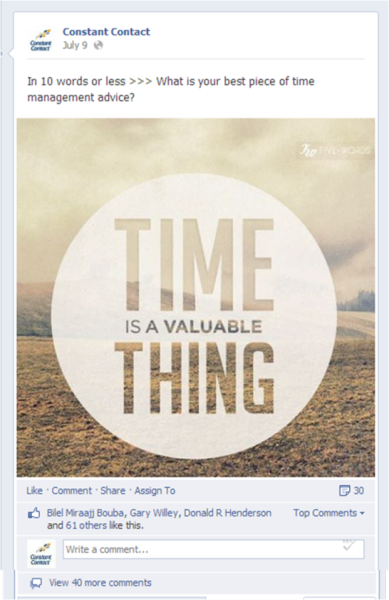
3. Posting during high-volume hours on Facebook
The best time to post on Facebook varies for each individual business page, but it’s important to keep news feed competition in mind. You already know how difficult it is to keep someone’s attention and stand out in a crowded news feed. When you post during the busiest hours of the day, you’re making your task even more challenging. During prime TV-watching hours, your posts are directly competing with your fans’ attention as they are engrossed in a favorite TV show, their friends, or the brands they follow and love. Increase your engagement by posting during non-busy hours.
4. Not telling your fans what you want them to do
Don’t be afraid to specifically ask your fans to engage in a particular way. A Facebook call-to-action that asks a fan to “like,” caption this, share, respond yes or no, or give a thumbs up receives 48 percent more engagement on average. Creating content that is authentic and relative to your brand makes it feel real and less like pushy marketing.
5. Sharing content that has nothing to do with your business
While posting that funny cat photo may garner some engagement, it is also likely to produce a higher rate of negative feedback (negative feedback is when fans hide or report your post as spam within the news feed.) This negative feedback hurts your page’s content performance based on the Facebook news feed algorithm. If you have a fun piece of content you’re dying to share, simply find a way to tie it back to your business. Here’s an example of how we made something fun, applicable to our business.

6. You want to discuss anti-social topics on social media
As much as you want to elicit responses from your fans, you should still always refrain from going on political rants, badmouthing competition, sharing overly personal content, complaining, and posting offensive content. In fact, positive content on Facebook gets more “likes” than negative content. You can spark a light-hearted debate to get your fans talking, but you should always stick to friendly, positive content.
7. Treating your content like traditional marketing
Social media marketing is different from traditional marketing. Traditional marketing focuses on promoting and pushing out information while social media marketing is all about pulling your current customers back in and increasing their loyalty. Facebook is a social two-way dialog, not a one-way broadcast. Make the most of this dialogue by listening, responding, and asking questions. The more authentic you are the more relationships you will build and the more your fans will want to engage with you.
8. You’re too focused on selling
Individuals use Facebook to connect and interact with other people. That’s why your Facebook Page should feel like a friend. Use a conversational tone, tell stories, listen, and respond to the folks that engage with your page. Also, remember the 80/20 rule. 80 percent of the content you post should be helpful or entertaining and 20 percent can be used for self-promotional or focused selling content.
9. Your posts lack consistency
Posting too often or irregularly can affect your engagement rate. Set an attainable goal for the amount of posts you want to publish each week. I recommend 3-4 times a week. By sticking to a schedule, you’ll generate regular engagement (Facebook’s new feed algorithm likes this.) It’s easy to lose track of the week and miss a post, which is why using the Facebook Scheduler to schedule half of your weekly posts can keep you on track.
10. Always posting the same type of content (links)
Images tend to draw more attention in the news feed and are great for generating engagement — mainly shares and likes. It’s easy to use images to tell a story about your business, highlight an event, or show off your products. When it comes to starting a conversation, text-only posts by far, receive the most comments. Varying the type of posts you share will keep your content fresh and help boost your engagement rate.
When it comes to Facebook engagement, many small businesses overestimate what’s needed for success. Don’t compare yourself to the big brands out there. It’s very challenging to get hundreds of “likes.” Compare yourself to yourself. A 5 percent improvement in engagement month over month is a success!
For more social media tips, “Like” us on Facebook!
On July 15th, Yahoo will be closing down inactive accounts (accounts that have not been logged into in the last 12 months) and releasing them to the public to claim.
That means that if you (or more importantly, customers on your email list) have not logged into your Yahoo account in the last year, then that Yahoo ID will become available and could soon be used by a completely different person.
Why you should care?
As a marketer, the change could have an immediate impact on the deliverability of your next email.
Say for example, johnsawyer@yahoo.com has been on your email list since 2010 but hasn’t logged into his account in the last 12 months. His email address could soon be claimed by another John Sawyer who is unfamiliar with your business, unsure why he is receiving your email, and quite frankly annoyed.
He will either unsubscribe or mark your email as spam. The latter can negatively affect whether ISPs such as Gmail and Outlook deliver your emails into the inbox, the junk box, or block it all together.
And what if no one claims johnsawyer@yahoo.com?
The account will still be closed and all emails sent to that address will bounce. This can also negatively impact your deliverability.
What should you do?
To avoid running into any deliverability problems after July 15th, send an email to all of your subscribers who use a Yahoo email address with a winning subject line and a request for them to update their preferences including their preferred email address.
This process is known as “cleaning” your list and is something that all email marketers should get in the habit of doing regularly. While this process may end up removing people from your list, they are inactive contacts that bring down your open rate and potentially prevent your emails from getting delivered to the contacts that are active and interested.
Start by creating a new list for all of your contacts using a “@yahoo.com” email address.
Here’s how to do it in your Constant Contact account:
Step 1: Login to your Constant Contact account and go to your Contacts page
Step 2: Under Search Contacts, search for all email addresses including “@yahoo.com”
Step 3: Click “Save as a List” and name your new list (Yahoo Email Contacts)
Once you have your new list, you can create your email.
The goal of the email is to find out which contacts are actually using their Yahoo email address and gain the best email address for them.
In the email, make sure to direct your reader’s attention to the “Update Profile” link automatically included in the footer of every email. This will give them the option to change their email address and update their email preferences in the process.
Here’s an example of what your email might look like:
Subject Line: Action Required: Confirm Your Interest
We want to make sure you’re still interested in receiving our emails.
To continue to receive our emails, click on the Update Profile link in the footer of this email to confirm your preferences. It’s really important that you click the link so that we don’t remove you from our email list if you’re still interested.
We value the relationship we have with you and want to make sure we’re offering the best experience possible. If you have any specific questions, feel free to hit the reply button and let us know what’s on your mind.
As always, thanks for reading!
After sending your email, you’ll be able to clean your list of all inactive Yahoo accounts.
If someone decides to change their email address, that change will be made to your list automatically.
You will also want to remove contacts who did not open your email, as they are likely inactive and could be shut down by Yahoo on July 15th. Wait 7-10 days after sending, and then take the following steps to clean your list.
Here’s how to remove inactive Yahoo email addresses from your Constant Contact account:
Step 1: After logging into Constant Contact, click Email > Reports.
Step 2: Go to the “Sent” column of the email listing and click the hyperlinked number.
Step 3: Click the “Save as List” button at the bottom of the page and name the category “Unopened.”
Step 4: Click the “Add Contacts to List” button.
Step 5: Go back to the “Reports” link and click the hyperlinked number under “Opens” to display the Opened Contact Email screen.
Step 6: Click the “Export” button at the bottom of the page and export as CSV on the next page.
Note: Your email must be less than 90 days old to export this information.
Step 7: Click the “Activity” link on the page that displays.
Step 8: After a few moments, click “Refresh” to verify that the “Export Unique Opens” has a status of complete (some lists may take longer to complete than others.)
Step 9: Once the export is completed, click the “Export Opens” link.
Step 10: Scroll to bottom of the screen and click “Download Export File.”
Step 11: Save this file to your desktop as “opens.csv”
Note: Are you experiencing delays when exporting your list from Constant Contact?
Step 12: Go to Contacts > Manage Contacts and select the “Remove List” option on the right-hand side.
Step 13: On the page displayed, go to Step 1 and select the “Unopened” list.
Step 14: Then scroll down to Step 2 and browse to the “opens.csv” file.
Step 15: Click “Remove.”
The value of cleaning your list
While updates like this can be frustrating, they also serve as a great reminder of the importance of keeping up with your contacts. Their email address and preferences change over time. People will be signing up, opting in; switching email addresses, and even changing their minds about when and why they want to receive emails from your business.
Don’t wait for announcements like these to stay on top of cleaning your email list. Remember, tomorrow’s success starts today. By scheduling regular check-ins with your readers, you’ll have more opportunities to keep up with these changes, stay in touch and relevant, and achieve your email marketing goals.
Still have questions or concerns about the latest Yahoo announcement? Post them in the comments below!
There are so many social media platforms out there today and everyone has a different opinion about which platform is best for your business.
As a marketing consultant, you probably dabble in all of the big social media sites for your clients but, which ones do you use for yourself?
Pinterest might be one of them.
This colorful social media platform is a great way to drive traffic back to your website and get even more exposure for your business. The question is…how do you use it as a marketing consultant? Most people will tell you that Pinterest is mainly for B2Cs (Business to Consumers) but, there are plenty of ways that B2Bs (Business to Business) and specifically marketing consultants can use Pinterest to grow their reach and drive traffic back to their site.
Below you will find 4 examples of how Constant Contact’s Solution Providers (our version of Marketing Consultants around the country) use Pinterest to their advantage.
1. Drive back to your content
Who: Shelley Roth
What: Driving back to your original content is a great example of how any B2B can use Pinterest. This platform gives you one more place on the internet that your current and prospective clients or customers can find your content. Pinterest can also help build your SEO (search engine optimization) and it allows videos. This is just one example of how Pinterest is a great way to drive traffic back to your website or original content.
2. Showcase your expertise
Who: Romona Foster of Admin Tech Consulting
What: As a Marketing Consultant, one of the most important things you can do is prove to your prospective clients that you know what you’re talking about. By creating “boards” around your specialty and expressing your knowledge through “pins,” you can really showcase your expertise. Romona, Social Media Trainer, does a great job at showing her knowledge by offering over 60 tips on how to use Pinterest and just using her Pinterest account correctly…bonus!
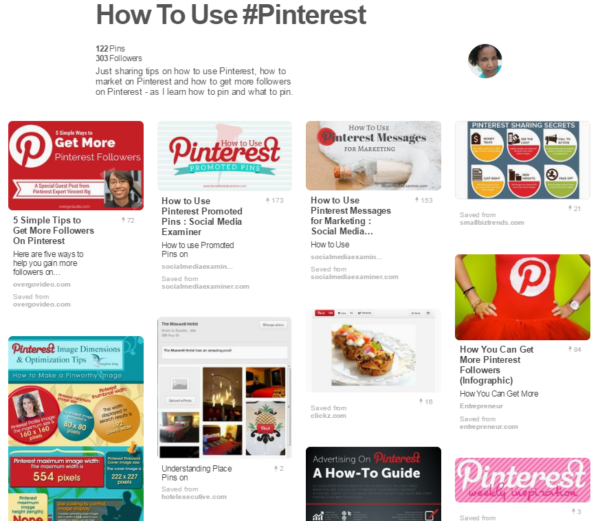
3. Let your personality shine through
Who: flyte new media
What: Pinterest is a great place to let the personality of your brand shine through. Social Media is unique because it allows you to have a little more fun than you would in traditional advertising and the name of your business may get in front of more people just from others “repinning” your fun content. So get out there and enjoy yourself!
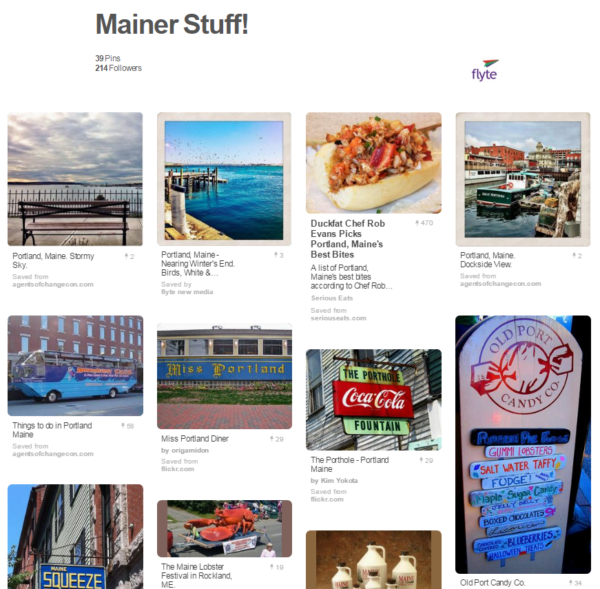
4. Show off your current clients
Who: BJC Branding
What: One of the best ways to convince your prospective clients or customers that they should go with your business is by highlighting the fabulous work you’ve already done. By creating a board with your current clients and projects, you not only get to brag about the work you’ve done but, you also have the opportunity to drive more traffic to your client’s websites. This is a win-win in my book.
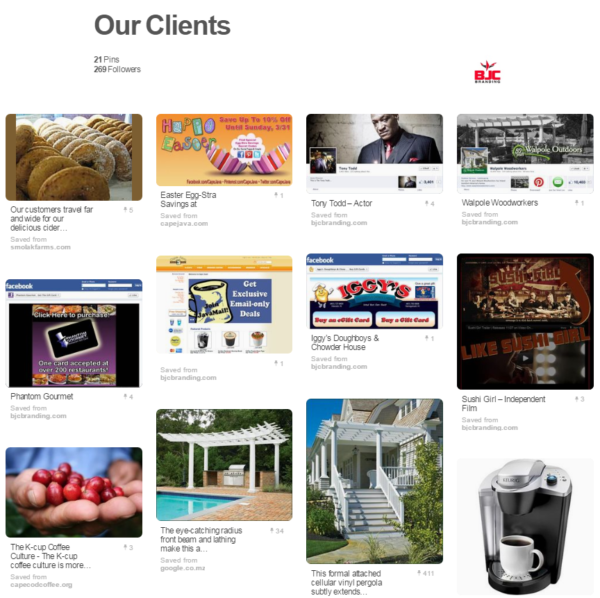
Give it a try
There are many ways B2B’s can use Pinterest to gain even more exposure and traffic to their brand and website. As a Marketing Consultant, you have a unique opportunity to use Pinterest to showcase what you’ve done, what you know, and why prospective clients should choose you.
Don’t feel confined by the “norm” either. There are many ways you can use Pinterest to brand yourself and your business as well as stay top of mind.
Go ahead…dive right in…and let us know how you’re using Pinterest for your business in the comment section below.
You’re likely aware that hashtags are now used across all major social media channels. But what exactly does that mean? Why are hashtags so important?
Let’s start at the beginning.
What is a hashtag?
A hashtag consists of words or phrases (with no spaces), preceded by a # sign (i.e. #SBW13 or #StanleyCup) that is used to tie various social media posts together and relate them to a topic. Topics are sometimes connected to an event, TV show, sporting event, or any happening or trend of your choosing. Originally, hashtags were created on Twitter, but today they can be used on Pinterest, Facebook, Google+, Instagram, LinkedIn, Tumblr, and Vine.
By clicking on a hashtag in a social post, that social network will automatically curate and display a feed of other messages also incorporating the same hashtag.
What is the point of a hashtag?
Hashtags let you add context to a post and show that it’s a part of a larger discussion. They can be good for connecting people to other individuals discussing the same topic and are also great for connecting people at events.
How can I use a hashtag?
To create a hashtag, simply include a # in front of a word or phrase, without spaces. A hashtag can occur at the beginning or the middle of a post. As a business, you can use a hashtag to make an event even more social, join other conversations, boost the visibility of a promotion or explore new content for content ideas.
How not to use a hashtag
Don’t abuse the hashtag, save it for when you need it. Too many hashtags looks spammy, and research has shown that engagement drops when a tweet has two or more hashtags.
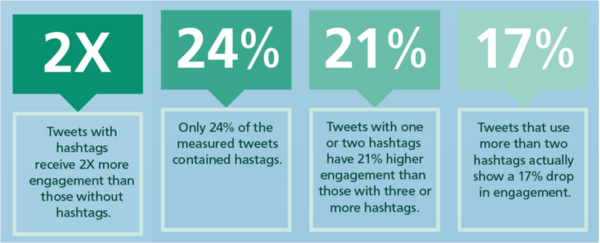
#DontCreateAHashtagThatsTooLong: Keep your hashtag short and sweet, easy to spell, and easy to remember. If you want to incorporate your hashtag across multiple channels, you need to consider the character restrictions of those social networks. If you’re creating a hashtag for an event with a long title like National Small Business Week 2013, consider using an abbreviation or acronym, #SBW13.
Extra Tip: Do a search for the hashtag you intend to use before you use it. You never know what people may be using hashtags to discuss. You wouldn’t want to accidentally connect your business to a negative, controversial or embarrassing topic.
It sounds complicated, why should I use a hashtag?
Whether you like them or not, hashtags are a key part of social media marketing. In fact, 71 percent of people on social media use hashtags. They aren’t that bad either. The same study found that 43 percent of hashtags users think they’re useful and 34 percent use them to follow categories and brands of personal interest like your business!
Stay on top of the all the latest social media and email marketing trends! Sign up for our Hints & Tips newsletter to get our best blog posts delivered to your inbox twice each month.
This week (June 2-8, 2013) is National Business Etiquette Week. I often run into people who think worrying about proper etiquette is passé. Personally, I couldn’t disagree more.
In today’s fast-paced, competitive market, I believe minding your Ps and Qs are more important than ever. Missteps in any business situation can tarnish your reputation, ruin your business relationships, and cost you valuable opportunities.
If you’re a little rusty on proper etiquette, this week is a good time to pull out your copy of Emily Post’s etiquette book, brush off the dust, and freshen up your skills. To help you evaluate how well you’re doing, I tasked some of my followers to share their biggest pet peeves. Here’s a list of the top five.
1. Turn it off
One of the biggest breaches of business etiquette is the use of a smartphone or other mobile device during meetings. Unless you’re dealing with some sort of an emergency, most emails, calls and text messages can wait until your business is concluded. So turn off your device and tune into your customers and clients.
“Many times I have seen people try to sneak a peek at their phone during a business dinner or simply set their phone down in the middle of a table, like it’s a part of the meeting. Developing business relationships are so important, and getting a chance to be physically present with colleagues or clients is becoming increasingly rare. Take full advantage of those opportunities by being present and making the people you are with feel important and valued. Turning your attention to your phone does not do that,” explains Taylor Rasted, BookVolume.com Account Manager.
2. Be respectful of time
Etiquette really boils down to showing respect to others. We all know in business that time is money, so disrespecting someone’s time is a huge faux pas. If you’re running late for a meeting, alert the person that you’re meeting with and explain the reason why.
“My biggest pet peeve, when it comes to business etiquette, is being aware of other people’s time. Paying attention to being timely for meetings, not overstaying your welcome, and being able to judge when a meeting will end are key factors to business success. Be succinct. Be prepared. Be aware of others and listen. I have a 15 minute rule when it comes to meetings. If someone has requested a meeting with me and is 15 minutes late, if I haven’t heard from them, I’m done. Of course there are exceptions for a true emergency situation, but as a general rule, that’s my policy, “says Deborah Sweeney, CEO of MyCorporation.com.
3. Too much information
Social media creates an interesting dynamic in the business world. Many of us use it for business and as a way to keep connected with family and friends. As a result, some people get too personal with the information they share, which may interfere with your business relationships and opportunities. Be careful what you post via social media platforms. If you wouldn’t want it broadcasted on the network news, then don’t post it.
4. Email overload
There is a general consensus that email abuse is rude and a huge “no-no.” Hitting “reply-all” for example when only one person needs to receive the information or vice a versa and failing to respond to all when the information should be shared with the group can be perceived as rude.
Elite Status Marcomm Founder and Managing Director, Julie Beltz says, “When people are inconvenient or incompetent about the cc line in email, it’s a huge business annoyance. Including the right people in the right conversations is essential for business success. The best tip is to review not just the content of the email, but also the recipients before hitting send.”
5. Too intimate
Being friendly in business is good, but too much intimacy can easily be misunderstood and misconstrued. Avoid sharing intimate details of your personal life in a business setting. A brief recap of a weekend trip is fine, but the ugly details of your recent break-up with your significant other or how horrible your step-children treat you is in poor taste.
While the business world may be getting less formal, practicing good etiquette remains important for success. You may not think other people care or pay attention, but they do. So brush up on your skills to help your small business enhance its success.
What is your business etiquette pet peeve? Share with us in the comments below.
About the Author: Susan Solovic is THE Small Business Expert. Sign up for Susan’s Success Tips Newsletter and get your free copy of “Smart Marketing Strategies for Small Biz” ebook.
Here’s something we could all stand to be reminded of from time to time: asking for help is a sign of strength, not weakness.
But even if you know that’s true, it’s still easy to feel intimidated when you’re making a BIG ask.
Boston-based nonprofit, Strong Women, Strong Girls (SWSG), is a mentoring organization that positively impacts thousands of young girls and women across the nation.
All with just 12 full-time staff members.
Their three tier mentoring program focuses on using relationships, skills, and role models to empower girls and women to succeed as leaders of their generation. With current locations spanning Boston, Pittsburgh, and South Florida, the small team relies on support from their community to keep the organization going strong.
Using SWSG as our model, let’s take a look at the steps you need to take for your ask to come across loud and clear.
1. Take the plunge
If you want to get your contacts to donate time, money or anything else, you’re going to have to gain their trust and confidence first. A great way to do that is with a professional and attention grabbing email newsletter.
If you’re new to the email marketing scene, creating an email newsletter might seem a little daunting at first.
That’s how it seemed to FAO Schwarz Fellow, Kayla Peck, when she joined the SWSG team 9 months ago. “When I first started, I didn’t have any communication experience so I was really coming from a novice perspective,” Kayla recalls. “Luckily, Constant Contact is really user friendly and it didn’t take me long to get a handle on it.”
Even if you’re interested in giving email marketing a try, you might still feel nervous about the time commitment.
“The biggest benefit of email marketing, from a staff perspective, is efficiency. I have a template made so it’s easy to pull together an email quickly,” Kayla explains. “I think the rest of my staff thinks it takes me a lot longer to create an email than it actually does!”
Ok, ready to jump in? Now you have to learn how to make your emails effective enough to inspire action.
2. Show off your strengths
The age-old writing mantra, “Show, don’t tell” can be applied to emails as well.
Because a lot of your contacts will be rifling through their emails quickly (and often on a small screen), it’s important that your emails are visually clear and easy to scan.
“We try to tell a story through pictures in our emails,” Kayla says. “Our emails are short, sweet, and structured so readers can get to the point quickly.”
Take a look at the email below. Using only three sentences of text, the email is effective in communicating a message to its recipient.
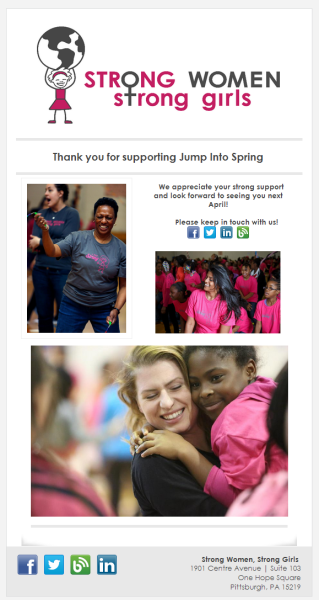
3. Be proud of your organization
The biggest mistake organizations make when asking for donations is shying away from what they’re asking for.
“Every spring we hold a large event called Jump into Spring. This is our largest event of the year, so we need as much help as we can get,” Kayla explains.
“With our emails, we give them multiple opportunities to get involved. It’s important for our contacts to understand that they are a crucial part of our community and their support, whatever they are able to give, is what keeps us going.”
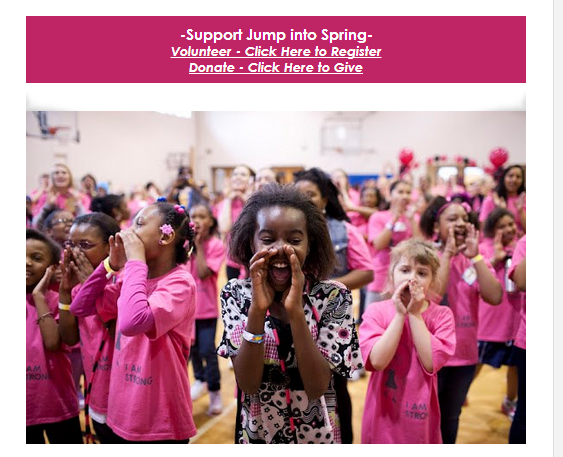
4. Make your donations page specific
In addition to making your ask prominent in your emails, it’s also a great idea to get specific in expressing why donations are important to your organization.
Let’s take a look at the explanation SWSG offers on their donations page:
Your donation goes a long way: $250 supports field trip supplies for a girl for a year, $100 supports a college mentor’s training, $50 supports a personalized coaching session for a team of 3-4 SWSG mentors, and $25 provides curriculum binders to a team of SWSG mentors. Please also consider providing long-term support through a recurring monthly gift!
These details can be a great motivator for someone on the fence about making a donation.
“We make sure to align all our language with our organization in mind,” explains Kayla. “We want anyone reading our information to feel close to our mission. We especially want them to realize and understand that they have an active and participatory role in our community.”
Ready to bring it all together? Take the plunge and follow SWSG’s lead with an ask that’s strong, proud, loud, and clear.
What’s your experience with “big asks?” What’s worked, what hasn’t worked? Tell us about it below.
Two-thirds of small businesses are on board, proving that mobile marketing is no longer the sole domain of major brands like Subway, Google, and Target. Given the growing interest in mobile marketing among small businesses, it seems worthwhile to take a deeper look at the survey results.
So, how exactly are small businesses using mobile technology?
More than 70 percent of small businesses are using mobile for social media marketing and email marketing — think Facebook updates and email newsletters that can be viewed on smartphones or tablets.
Forty-four percent are conducting mobile advertising through social platforms.
When asked what types of mobile/social advertising they use, 97 percent of respondents said they use social media platforms like YouTube, Pinterest, Twitter, Facebook, and Instagram. Location-based promotions (Foursquare check-in, etc.) came in a distant second at 17 percent and text messages came in third at 15 percent.
Another interesting survey tidbit — small business owners are big Apple fans. iPhone users trump Android users 66 percent to 39 percent. Sounds like Apple’s carved out a good small business niche given that among the general population, Android subscribers account for more than half of all subscribers while iOS subscribers account for just 38 percent.
By now you’ve probably heard the ubiquitous stat that claims there are more mobile phones than toothbrushes on the planet, so it’s great to see small businesses taking advantage of mobile marketing. And why not? It’s a fast and direct way to reach customers and mobile advertising can be very cost-effective. There’s no denying our mobile-optimized world and it’s not going away, especially when you consider some analysts are predicting that mobile searches will surpass desktop searches this year.
Of course, there’s always the flip side of the coin and that leads us to the 34 percent of small businesses who’ve not yet boarded the mobile train.
Why not? A lack of customer demand?
Fifty-six percent say their customers haven’t expressed a demand for mobile communications and 47 percent say their customers haven’t expressed a demand for mobile payment solutions. More than a few respondents even said things like, “I have no idea how this stuff works.” The problem with this wait-and-see approach is that you may miss some prime marketing opportunities. Not convinced? Consider the fact that 42% of emails are opened on mobile devices and 1 in 5 internet users don’t use a computer. Mobile is a way of life and smart small business marketers need to climb aboard before this train leaves the station.
And now, a question for you: Are you using mobile to market your business and if so, how?
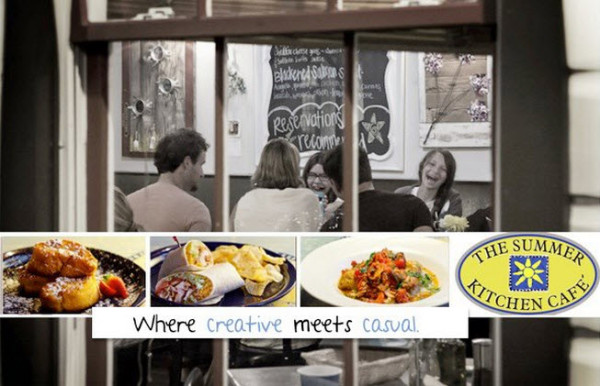 Unless you’ve been hiding under a rock for the last few years, you know that the way consumers find local businesses has fundamentally changed.
Unless you’ve been hiding under a rock for the last few years, you know that the way consumers find local businesses has fundamentally changed.
This is something that all local business owners need to be aware of, but it is especially important for local merchants who own or manage a restaurant.
Take James Dillon, owner of the Summer Kitchen Café in Rosemary Beach, FL. When James opened for business in 1999, most restaurants were not thinking about the value of having their menus available online.
“When we first got started, we actually walked around handing out paper copies of our menu,” James recalls. “A lot has changed since then.”
Part of what’s changed for restaurant owners like James is that the needs of his customers have also changed drastically. Paper menus, print advertisements, and passing foot traffic are no longer enough to bring new customers through your door.
Customers are searching for businesses on their mobile devices, checking review sites and online listings, and using social media to connect with their favorite restaurants and local businesses.
“Today, there’s so much more we need to be doing,” explains James. “It’s something we’ve started paying attention to in the last few years.”
The danger of not being in control of your own information
Like a lot of restaurant owners, James jumped into the online world by first creating a website and eventually getting started on Facebook.
He then began to use search engines to search for his business online. The good news was that there was already a lot of information out there about Summer Kitchen Café. The bad news was that most of that information hadn’t been updated in almost a decade.
“I’m not sure if everyone is cognizant of the information that’s out there, but the stuff that’s online really never dies,” explains James. “We found menus on some sites that were 10 years old and had never been updated. It really got my attention.”
With the help of his daughter, James began looking into how he could take control of the information that was out there. Their first attempt was to track these menus down one-by-one.
“The process was way too cumbersome,” James recalls. “On some sites the menus were embedded, on others we found outdated pdfs. It was impossible to keep everything up-to-date.”
Fed up, James decided to look for a better option.
“We began looking for an easy platform that would let us update our menus and distribute them more easily,” explains James. “That’s when we discovered Single Platform.”
Managing expectations
At first, James wasn’t sure what to expect. Up to that point, keeping up with his online listings had been a nightmare with more negatives than positives for his business.
After working with a representative at SinglePlatform to set up his new digital listing however, James’s expectations slowly began to change.
“We were surprised at how easy it was to use,” James recalls. “To be able to update our menu in a single location and have it published in so many places without any extra work has been a huge timesaver.”
With SinglePlatform, the hours James had spent updating menus online were replaced with a few easy steps. Now when a change or update was made to the menu, it would repopulate on sites like TripAdvisor, UrbanSpoon, YellowPages, and other places he knew his customers were searching.
Finding time to do more
With less time spent keeping track of online listings, James says he has more time to help grow his business.
“We’re focused now on improving our own site and doing more on social media as well,” explains James. “Being able to have our menu populate on our website and Facebook has been a huge help.”
Now, no matter where people are discovering Summer Kitchen Café—whether it’s on their website, through Facebook, or via an online search—James knows the menu they find will be the same one being offered at Summer Kitchen Café that very day.
That’s also freed him up to be more proactive about getting that information in front of his target audience.
With SinglePlatform’s social media tools James has the ability to schedule and share special announcements with his more than 1,100 Fans on Facebook. He has also started encouraging Fans and patrons at the café to help “share the love” and review Summer Kitchen Café on sites like Yelp and Urban Spoon.
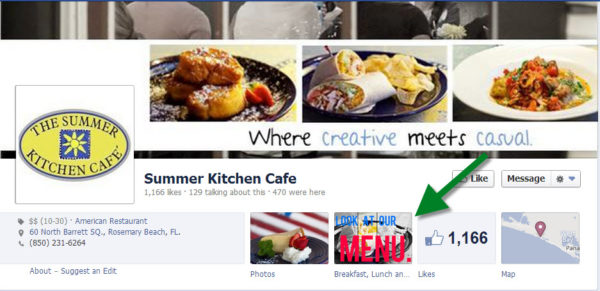 Why it’s important for small businesses to evolve to meet the needs of their customers
Why it’s important for small businesses to evolve to meet the needs of their customers
A lot has changed for James since the days of passing out paper menus to local residents. What hasn’t changed however is the type of service or the quality of the dishes being offered at Summer Kitchen Café.
That’s great news for James and his customers. Today it’s never been easier for people to find out what’s on the menu.
“We depend on customers being able to find us—whether they live in our community or are located hundreds of miles away,” James explains. “Knowing we’ll be found in the places our customers are already searching has given us peace of mind.”
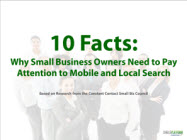 Want to learn more about the evolving needs of today’s consumers? Download the free eBook from SinglePlatform Why Small Business Owners Need to Pay Attention to Mobile and Local Search.
Want to learn more about the evolving needs of today’s consumers? Download the free eBook from SinglePlatform Why Small Business Owners Need to Pay Attention to Mobile and Local Search.
Let’s be honest, no one enjoys having people unsubscribe from their email contact list.
With all the work you put into growing your list and the time you spend designing, creating, and sending emails—it’s never fun when someone decides to say thanks but no thanks.
But while losing contacts is something we all dread, it’s also a reality we all must accept.
Whether you’re an email marketing expert, with years of experience and thousands of contacts on your list or a business owner who’s just getting started—you’re going to have people who decide to unsubscribe from your list.
And while you certainly cannot (and should not) expect people to stay on your list forever, you can certainly learn a lot when they decide to walk away.
It’s not goodbye, it’s just see you later
Having someone unsubscribe from your emails is not the end of the world. And in most cases, it’s not the end of your relationship with that customer or client either.
Customer relationships don’t begin and end with an email signup or unsubscribe. For your customers, signing up for your email list is an added bonus of being a loyal customer. Their reasons for signing up will be different based on their particular needs and interests but overall, joining your list is about making life easier for them.
Just because they opt-out doesn’t necessarily mean they’re done being a customer.
So why are people choosing to opt-out from your list?
We asked 1,400 consumers that very question. Here’s what they had to say:
- 69% Too many emails from the business/organization
- 56% The content is no longer relevant
- 51% The content wasn’t what I expected
As you can see, for these consumers the decision to opt out had less to do with their perception of the business and much more to do with the overall email marketing strategy.
Just as consumers sign up with certain needs and interests, they also sign up with different expectations for what they’re going to receive. When you fail to deliver on those expectations, you lessen the chance of keeping contacts engaged and increase the chance of having them unsubscribe from your list.
How to learn from customers who unsubscribe
While you shouldn’t bang your head against the wall every time someone decides to unsubscribe, you should take the time to better understand the factors that lead to their decision to opt out.
That doesn’t mean confronting them in your store or calling them to ask them to explain themselves. (If their decision to unsubscribe didn’t end their relationship with your business; that most certainly would.)
But there is information readily available to you today, that you can use to develop a better understanding of why people decide to opt out.
First off, you have your reports
Looking at your email reporting is the easiest way to track the effectiveness of your email marketing campaigns. The “positive” metrics like opens and click-through rates allow you to see the type of interest your emails are generating and the type of engagement that’s actually taking place.
The “negative” metrics like opt-outs and spam reports have a lot to teach you about your email marketing as well.
Your opt-out rate shows how many people received an email from your business and made the decision to unsubscribe.
Having a few opt-outs per email, shouldn’t trigger any red flags. In fact, by giving those readers the opportunity to opt-out you’ll likely be improving other metrics because you’ll be removing less unengaged contacts from your list. (We typically say that around 2% is a normal opt-out rate for an email campaign.)
A spike in opt-outs, however, is typically the result of a change that did not go over well with your readers. Remember that the top reasons people unsubscribe are related to frequency, content, and subscriber expectations.
In addition to looking at the content and frequency of your emails, you’ll also want to consider how your list changed over that particular period. If you’ve recently begun sending to a new list of contacts or ran a promotion to help grow your list, there may be a period where some of these contacts decide to opt-out.
But if each time you add a new group of contacts, your opt-out rates for the next email go through the roof, you may need to take a fresh look at the signup process you’re offering consumers. It may indicate readers were expecting something different when they decided to join your list.
You can also ask readers why they’re opting-out when they unsubscribe
This is something business owners often have mixed feelings about. After all, they’ve already unsubscribed, will knowing why really make a difference?
But by giving people the opportunity to provide a reason for opting-out, you’ll not only collect valuable feedback, you’ll also be giving customers the chance to better explain their decision.
Both can go a long way in helping improve your email marketing going forward.
How this feedback can help improve your own email marketing
I recently took a look at one local business’ opt-out rates to see what I could learn. The business is a retail store located in my hometown and I have recently been helping them make some improvements to their email marketing strategy.
Because recent results have been trending in the right direction and opt-out rates have been consistently low, I didn’t expect to see anything that would indicate that major improvements would need to be made.
And for the most part, I was right.
Nearly half of the people who decided to unsubscribe did so based on their proximity to the business—some had recently moved elsewhere and others had signed up while on vacation and no longer needed updates about new products, specials, or events.
The other half were people who unsubscribed based on the volume of emails they were receiving each day. For them the frequency of email—not only from us but from all of the brands they had subscribed to—had become a problem and they needed to scale back on the information coming to their inbox each day.
On one hand, this feedback was reassuring. So maybe we had lost a few contacts, we had also seen a lot of success from the last few campaigns. And what could we really do to keep people on the list that had moved out of state or decided that one email newsletter per month was more than they could handle?
On the other hand, all of the products the business offers in-store are readily available online. Maybe we could have done a better job at promoting e-commerce sales, rather than trying to talk to every reader as if they lived just a few blocks away.
And why couldn’t we offer new contacts the opportunity to sign up to receive emails once a quarter, rather than once a month?
Neither of these changes would have taken much extra work and could have kept at least some of these contacts from opting out from their list.
Small improvements can make a big difference
In most cases, the changes you make from keeping tabs on your opt-outs and collecting feedback from readers who decide to unsubscribe will be small.
Maybe it will mean trying different types of content, revamping the signup experience you’re offering new contacts, or scaling back on the frequency of emails you’re sending your list.
But while these changes may be small, the impact can make a big difference when it comes to maintaining email relationships and driving more results from your email marketing.
I know I’ll be using the lessons I learned to help one of my favorite local businesses, I hope you’ll consider doing the same for yours as well!
You’ve heard the saying that ‘size isn’t everything’–and that’s true, but only if you use what you’ve got in the right way.
Of course I’m talking about the header on your email newsletter (I don’t know what you were thinking!), and I’m going to tell you why this is true.
Your newsletter header is really important because it’s the first thing that people see when they open your email, and if they’re reading your newsletter in their ‘preview’ pane, it might be the ONLY thing they see without scrolling down, so you have to make it count.
Here’s an example from Andy Lopata, UK networking expert. This is what you see if you are using a short preview pane, and I’ll explain what makes it work:
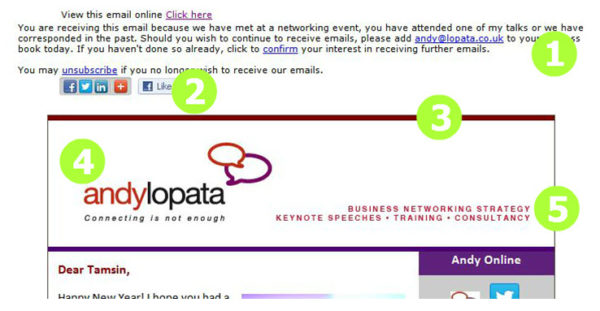
1. Permission reminder
It seems counter-intuitive, but the more chances you give to your readers to unsubscribe, the less likely they are to do it. So, using a permission reminder will help reduce your unsubscribe rate.
It will also help reduce the number of spam reports that your emails receive (and that’s a VERY good thing). This is because a reader who doesn’t want to receive your emails any more will easily see the unsubscribe link in the permission reminder and is more likely to use it, rather than marking your email as junk or spam using the button in their email client.
2. Social Share Bar
We hang around (online and offline) with other people like us. So if I am a good customer for you, it’s likely that my friends could be too. The Social Share Bar harnesses this power by making it easy for your readers to share your email with their friends and associates via a host of social media networks—and because their friends could be your target customers, you really want them to do that. When you make it easy, your readers are more likely to take action.
3. Brand colours
Andy has a very clear brand image and he uses his brand colours consistently through all marketing materials that he produces. So, his newsletter is no exception with the crisp white banner topped and tailed with his trademark red and purple.
This creates consistency and recognition as soon as readers see his newsletter in their inbox.
4. Logo and strapline
Always, always, ALWAYS put your logo in your newsletter banner. Your logo should be one of the key ways that your customers recognize you, so get it in there.
Don’t make it too big or too small—you want it to be clear and legible but not to push the content of your newsletter down by being too big.
Newsletter tip: Make your logo a link back to your website homepage. We are trained to click on logos for links, so use this to your advantage and get readers visiting your website.
5. Business description
You can fit a lot in your newsletter banner, but many people just put their logo in there and waste the rest of the space. In this example, Andy has used the remaining space to remind readers about what he does and how he can help them.
After the header, Andy’s content can be seen just peeping up into the ‘preview zone’, so you’ll note that a bold and colourful greeting and links to find Andy online can be clearly spotted. These things aren’t part of his header, but serve to show that there’s more to come, and draw the reader’s eyes towards his newsletter content.
The internet has trained us to scroll down when we can’t see the whole of a particular block of text or image, so by having the start of the content visible in those top two inches, readers are more likely to scroll (or open the email fully) and jump straight into the content, and that’s what we want people to do.
Key takaways:
You can use these principles in your email newsletter header too, just make sure that you’ve got the following covered:
- Visual recognition through your logo and brand colours
- Reduce spam reports and opt-outs with a permission reminder
- Encourage sharing with the Social Share Bar
- Remind people how you can help them with your strapline and/or business description
- Make your banner and logo a link to your website
- Encourage scrolling by making the rest of your content apparent
Do you have any tips for an email header that works? Tell me about them in the comments.
When you’re a small business, you have one distinct advantage over the big guys: customer relationships.
Every time you’re talking with a customer in store, emailing someone who has a question, or answering the phone, you’re building a relationship. The odds are good that you know the name of your customers and what they like. You may even know a bit about their personal lives.
It’s almost impossible for bigger companies to establish the same connection with customers (that’s why those that do really stand out).
In the days of social media marketing and the ultra-connected customer, your ability to build relationships can be the biggest advantage you have.
Let’s take a look at why that is:
1. Your business has a personality
You have a personality.
When you allow your personality into your business, it separates you from the competition and allows people the opportunity to connect with you.
Everything from the set-up of your store to your Facebook Page is going to reflect that.
That’s what compels people to return to small businesses in the first place. People like to do business with those they know, like, and trust.
Sure, convenience and prices are factors in their purchasing decision, but keep in mind that a great experience is also a deciding factor.
So, ask yourself:
- How do I show the personality of my business across all points of contact? (I.e. in store, on my website, in my emails, etc.)
- How can I use my personality to create a memorable—or Wow!—experience for my customers?
2. You know your customers
You know your customers in a way that big businesses don’t. If someone tweets you, you may know who they are. If they call the store, you probably know their name.
Your customers will remember their interactions with you, whether it was virtually or face-to-face. If it was a good interaction, they’ll tell friends about it and they’ll keep coming back.
You can take that relationship to the next level by asking:
- How can I give my customers recommendations that suit their individual needs?
- What kinds of discounts and deals can I offer that I know my customers will like?
- How do I market my business to the customers I already know, so I can keep them coming back and get people with similar interests coming to my store?
3. You can build relationships that last
A lot of your customers are coming to you because they genuinely like your business, and the more times they come back, the more likely they are to become your most loyal fans.
You’re in charge of making sure that your business flourishes and having long-lasting relationships can be the most important part of that growth.
Small businesses know that repeat customers and loyalty are the best parts of having relationships in the first place. You get to know your customers and they become personally invested in your business.
So, ask yourself:
- How do I make sure that my relationships with customers last?
- What do I do to reward customers who keep coming back?
- How can I continue to build those relationships?
The next steps
The odds are good that you already have great relationships with your customers.
Continue to focus on those relationships. You’ll find that your current customers are your best source of new business, because they end up marketing your business for you through word-of-mouth.
Of course, you may have noticed word-of-mouth has been rapidly changing over the past decade thanks to social media and mobile devices.
When I teach Constant Contact’s Successful Email Marketing Boot Camp classes, one question I get in every class is whether or not social media buttons belong in emails.
My answer: Yes, absolutely.
Social Media buttons that connect to your company’s Facebook Page, Twitter account, LinkedIn Profile, etc. should be in every single email you send. These buttons give your contacts an opportunity to connect with you in ways they may not have known were possible. And one of the sites you are linking to may be your customers’ preferred way of getting new information from your business.
So how do you decide where to put social media buttons in the email?
Unless the specific goal of your email is to drive people to your social networks, these social media buttons serve as a secondary action for your contacts to take. There are usually two great locations to put them.
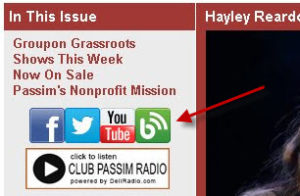 If your email has a sidebar, I recommend your social media links be located somewhere in the top third of your email.
If your email has a sidebar, I recommend your social media links be located somewhere in the top third of your email.
This means the buttons will be visible to everyone who opens your email, regardless of whether or not they take the time to read through the entire message.
If you’re using a short, focused single-column template, the bottom of your email is a great location for your social media buttons.

In either case, Constant Contact makes it easy to add these pre-made, branded social media buttons to your emails. Remember, you are giving your contacts an opportunity to connect with your business in another way.
Won’t the buttons take my contacts away from my email?
No need to worry. As mentioned above, these buttons usually serve as a secondary action. Also, the social media link they click on opens in a new tab in your browser. Your email will still be easy to return to with a simple click.
Other ways to make your email more social
We also offer two other tools that can help you and your customers share your email on a number of social media sites. What are these two extra tools you ask? Don’t worry; I’m not in the business of keeping secrets that will help our customers succeed!
#1 – Social Share Bar:
 You can find the Social Share Bar in the “Header Options” of your email.
You can find the Social Share Bar in the “Header Options” of your email.
When you select to include the Social Share Bar it adds a bar to the top of your email so that your contacts can share your email on their social media profiles and pages. This gives your customers the opportunity to spread the word about your business to their networks and can give your email much longer legs than it would have otherwise.
#2 – Simple Share:
Simple Share is a little different from the Social Share Bar in that it doesn’t add anything to your email but allows you to automatically share your email on your social media sites when your email goes out! How great is that? Also, you can easily re-post an email to your social media sites in the reports section of any recently sent email.

Show off your social presence
So this year, make it a resolution to show off your social media presence in all of your emails. Give your customers as many ways as possible to connect with you and share your emails.
Do you learn by doing? Come to one of our “Successful Email Marketing” hands-on workshops. We’ll show you how to create effective email marketing campaigns that get results. See when our workshops are in your area.

